Motorola Mobility T56CB2 Portable Cellular / PCS GSM Transceiver User Manual Exhibit 8 Preliminary Users Manual
Motorola Mobility LLC Portable Cellular / PCS GSM Transceiver Exhibit 8 Preliminary Users Manual
Exhibit 8 Preliminary Users Manual

APPLICANT: MOTOROLA, INC. FCC ID: IHDT56CB2
EXHIBIT 8
INSTRUCTION MANUAL
A preliminary draft copy of the Users Manual follows:
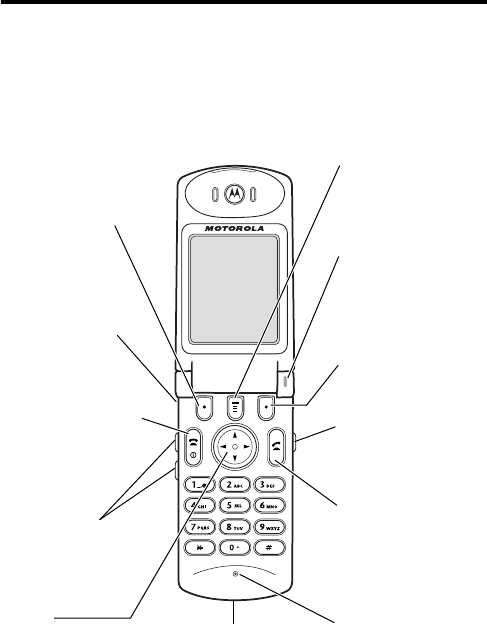
1
PRELIMINARY
Welcome
Welcome to the world of Motorola digital wireless
communications! We are pleased that you have chosen the
Motorola T720 GSM wireless phone.
Headset Jack
Insert headset
accessory for
hands-free use.
Status Light
See incoming call
and service status.
Volume Keys
Adjust earpiece
and ringer volume.
Voice Key
Record voice notes,
phonebook and
shortcut names.
Microphone
Accessory
Connector Port
Insert charger and
phone accessories.
Power Key
& End Key
Turn phone on and
off, end phone
calls, exit menu
system.
Right Soft Key
Perform functions
identified by right
display prompt.
Menu Key
Left Soft Key
Perform functions
identified by left
display prompt.
Send Key
Send and answer
calls, view recent
dialed calls list.
4-Way
Navigation Key
Scroll through
menus and lists,
set feature values.
2
PRELIMINARY
Personal Communications Sector
600 North U.S. Highway 45
Libertyville, Illinois 60048
1-800-331-6456 (United States)
1-888-390-6456 (TTY/TDD United States)
1-800-461-4575 (Canada)
www.motorola.com
(United States)
www.motorola.ca
(Canada)
MOTOROLA, the Stylized M Logo and all other trademarks indicated as
such herein are trademarks of Motorola, Inc. ® Reg. U.S. Pat. & Tm. Off.
TrueSync, Sidekick, Starfish and the Stylized Starfish Logo are registered
trademarks of Starfish Software, Inc., a wholly owned independent
subsidiary of Motorola, Inc. Java and all other Java-based marks are
trademarks or registered trademarks of Sun Microsystems, Inc. in the
U.S. and other countries. All other product or service names are the
property of their respective owners.
© 2002 Motorola, Inc. All rights reserved.
Software Copyright Notice
The Motorola products described in this manual may include copyrighted
Motorola and third party software stored in semiconductor memories or
other media. Laws in the United States and other countries preserve for
Motorola and third party software providers certain exclusive rights for
copyrighted software, such as the exclusive rights to distribute or
reproduce the copyrighted software. Accordingly, any copyrighted
software contained in the Motorola products may not be modified,
reverse-engineered, distributed, or reproduced in any manner to the
extent allowed by law. Furthermore, the purchase of the Motorola
products shall not be deemed to grant either directly or by implication,
estoppel, or otherwise, any license under the copyrights, patents, or
patent applications of Motorola or any third party software provider,
except for the normal, non-exclusive, royalty-free license to use that
arises by operation of law in the sale of a product.
Manual number: 6809441A06-O
Cover number: 8988485L49-O

3
PRELIMINARY
Menu Map
Main Menu
• Media Center
• Picture Viewer
• My Tones
• Radio
• Games & Apps
• Voice Notes
• Shortcuts
• Calculator
• Settings
(see next page)
• Chat
• Web Access
• Browser
• Web Shortcuts
• Stored Pages
• History
• Goto URL
• Browser Setup
• More
(go to following menu items)
• Services
• SIM Toolkit
• Fixed Dial
• Service Dial
• Quick Dial
• Web Sessions
• Phonebook
• Messages
• Create Message
• Voicemail
• Text Msgs
• Email Msgs
• Browser Alerts
• Info Services
• Quick Notes
• Outbox
• Drafts
• Datebook
• Recent Calls
• Received Calls
• Dialed Calls
• Notepad
• Call Times
• Call Cost
• Data Times
• Data Volumes
• Ring Styles
• Style
•
Style
Detail
This is the standard phone menu layout.
Menu organization and feature names
may vary on your phone. Not all
features may be available for all users.
For example, the Radio option under
Media Center (left) is available only
when the optional FM Stereo Radio
Headset accessory is plugged into your
phone.
Shortcuts
Change display zoom:
Press
M
, then
press and hold
M
Change ringer alert:
Press down volume key to
switch to vibrate alert, then
silent alert. Press up volume
key to reset ring alert.
Display my phone number:
Press
M
#
Go to dialed calls list:
Press
N
Exit menu system:
Press
O
4
PRELIMINARY
Settings Menu
• Personalize
• Main Menu
• Home Keys
• Color Style
• Greeting
• Banner Graphic
• Wallpaper
• Screen Saver
• Quick Dial
• Call Forward
• Voice Calls
• Fax Calls
• Data Calls
• Cancel All
• Forward Status
• In-Call Setup
• In-Call Timer
• Call Cost Setup
• My Caller ID
• Talk and Fax
• Answer Options
• Call Waiting
• Phone Status
• My Tel. Numbers
• Credit Info/Available
• Active Line
• Battery Meter
• Other Information
• Security
• Phone Lock
• Lock Application
• Fixed Dial
• Call Barring
• SIM Pin
• New Passwords
• Initial Setup
• Time and Date
• 1-Touch Dial
• Auto Redial
• Backlight
• Status Light
• Zoom
• Scroll
• Animation
• Language
• Battery Save
• Contrast
• DTMF
• Master Reset
• Master Clear
• Java Tools
• Java System
• Network Access
• DNS IP
• Network
• Car Settings
• Headset

5
PRELIMINARY
Contents
Menu Map
. . . . . . . . . . . . . . . . . . . . . . . . . . . . . . . . . . . . . 3
Safety and General Information
. . . . . . . . . . . . . . . . . . . . 8
Getting Started
. . . . . . . . . . . . . . . . . . . . . . . . . . . . . . . . 14
What’s in the Box?. . . . . . . . . . . . . . . . . . . . . . . . . . . . . 14
About This Guide. . . . . . . . . . . . . . . . . . . . . . . . . . . . . . 14
Installing the SIM Card . . . . . . . . . . . . . . . . . . . . . . . . . 15
Installing the Battery . . . . . . . . . . . . . . . . . . . . . . . . . . . 17
Charging the Battery . . . . . . . . . . . . . . . . . . . . . . . . . . . 18
Battery Use . . . . . . . . . . . . . . . . . . . . . . . . . . . . . . . . . . 19
Changing the Convertible Covers . . . . . . . . . . . . . . . . . 21
Turning Your Phone On . . . . . . . . . . . . . . . . . . . . . . . . . 22
Viewing Your Phone Number. . . . . . . . . . . . . . . . . . . . . 22
Adjusting Volume. . . . . . . . . . . . . . . . . . . . . . . . . . . . . . 23
Making a Call. . . . . . . . . . . . . . . . . . . . . . . . . . . . . . . . . 23
Answering a Call . . . . . . . . . . . . . . . . . . . . . . . . . . . . . . 24
Learning to Use Your Phone
. . . . . . . . . . . . . . . . . . . . . 25
Using the Display . . . . . . . . . . . . . . . . . . . . . . . . . . . . . 25
Using Menus . . . . . . . . . . . . . . . . . . . . . . . . . . . . . . . . . 28
Entering Text . . . . . . . . . . . . . . . . . . . . . . . . . . . . . . . . . 30
Other Phone Features. . . . . . . . . . . . . . . . . . . . . . . . . . 36
Calling Features
. . . . . . . . . . . . . . . . . . . . . . . . . . . . . . . 38
Redialing a Number. . . . . . . . . . . . . . . . . . . . . . . . . . . . 38
Using Caller ID . . . . . . . . . . . . . . . . . . . . . . . . . . . . . . . 38
Calling an Emergency Number . . . . . . . . . . . . . . . . . . . 39
Dialing an International Number . . . . . . . . . . . . . . . . . . 40
Viewing Recent Calls . . . . . . . . . . . . . . . . . . . . . . . . . . 40
Calling With Speed Dial. . . . . . . . . . . . . . . . . . . . . . . . . 41
Calling With 1-Touch Dial . . . . . . . . . . . . . . . . . . . . . . . 41
6
PRELIMINARY
Using Voicemail. . . . . . . . . . . . . . . . . . . . . . . . . . . . . . . . 41
Using Call Waiting. . . . . . . . . . . . . . . . . . . . . . . . . . . . . . 43
Other Calling Features . . . . . . . . . . . . . . . . . . . . . . . . . . 44
Messages and Chat
. . . . . . . . . . . . . . . . . . . . . . . . . . . . . 46
Sending a Text Message. . . . . . . . . . . . . . . . . . . . . . . . . 46
Receiving a Text Message . . . . . . . . . . . . . . . . . . . . . . . 48
Other Message Features . . . . . . . . . . . . . . . . . . . . . . . . 49
Using Chat . . . . . . . . . . . . . . . . . . . . . . . . . . . . . . . . . . . 50
Other Chat Features . . . . . . . . . . . . . . . . . . . . . . . . . . . . 52
Email
. . . . . . . . . . . . . . . . . . . . . . . . . . . . . . . . . . . . . . . . . 53
Sending an Email Message . . . . . . . . . . . . . . . . . . . . . . 53
Receiving an Email Message . . . . . . . . . . . . . . . . . . . . . 55
Other Email Features . . . . . . . . . . . . . . . . . . . . . . . . . . . 56
Setting Up Your Phonebook
. . . . . . . . . . . . . . . . . . . . . . . 57
Viewing Entry Details . . . . . . . . . . . . . . . . . . . . . . . . . . . 57
Creating a Phonebook Entry. . . . . . . . . . . . . . . . . . . . . . 58
Storing a PIN Code With the Phone Number . . . . . . . . . 60
Recording a Voice Name For a Phonebook Entry . . . . . 61
Dialing a Phonebook Entry . . . . . . . . . . . . . . . . . . . . . . . 62
Editing a Phonebook Entry . . . . . . . . . . . . . . . . . . . . . . . 63
Personalizing Your Phone
. . . . . . . . . . . . . . . . . . . . . . . . 64
Setting a Ring Style . . . . . . . . . . . . . . . . . . . . . . . . . . . . 64
Personalizing a Ring Style . . . . . . . . . . . . . . . . . . . . . . . 65
Other Personalization Features . . . . . . . . . . . . . . . . . . . 65
Getting More Out Of Your Phone
. . . . . . . . . . . . . . . . . . . 68
Dialing Features . . . . . . . . . . . . . . . . . . . . . . . . . . . . . . . 68
Hands-Free Features . . . . . . . . . . . . . . . . . . . . . . . . . . . 69
Data and Fax Call Features . . . . . . . . . . . . . . . . . . . . . . 70
Call Monitoring Features. . . . . . . . . . . . . . . . . . . . . . . . . 70
Network Features . . . . . . . . . . . . . . . . . . . . . . . . . . . . . . 71
7
PRELIMINARY
Security
. . . . . . . . . . . . . . . . . . . . . . . . . . . . . . . . . . . . . . 72
Locking and Unlocking Your Phone . . . . . . . . . . . . . . . . 72
Changing a Code, PIN, or Password. . . . . . . . . . . . . . . 73
If You Forget a Code, PIN, or Password . . . . . . . . . . . . 74
Other Security Features . . . . . . . . . . . . . . . . . . . . . . . . 75
Personal Organizer Features
. . . . . . . . . . . . . . . . . . . . . 76
Datebook. . . . . . . . . . . . . . . . . . . . . . . . . . . . . . . . . . . . 76
Alarm Clock. . . . . . . . . . . . . . . . . . . . . . . . . . . . . . . . . . 77
Voice Notes . . . . . . . . . . . . . . . . . . . . . . . . . . . . . . . . . . 77
Calculator . . . . . . . . . . . . . . . . . . . . . . . . . . . . . . . . . . . 77
News and Entertainment
. . . . . . . . . . . . . . . . . . . . . . . . 79
Micro-Browser . . . . . . . . . . . . . . . . . . . . . . . . . . . . . . . . 79
Games and Applications . . . . . . . . . . . . . . . . . . . . . . . . 80
Other Entertainment Features. . . . . . . . . . . . . . . . . . . . 81
Specific Absorption Rate Data
. . . . . . . . . . . . . . . . . . . 83
Additional Health and Safety Information
. . . . . . . . . . 85
Warranty
. . . . . . . . . . . . . . . . . . . . . . . . . . . . . . . . . . . . . 93
Product Registration
. . . . . . . . . . . . . . . . . . . . . . . . . . . 98
Export Law Assurances
. . . . . . . . . . . . . . . . . . . . . . . . . 98
Index
. . . . . . . . . . . . . . . . . . . . . . . . . . . . . . . . . . . . . . . . . 99
Wireless Phone Safety Tips
. . . . . . . . . . . . . . . . . . . . . 109

8
PRELIMINARY
Safety and General
Information
IMPORTANT INFORMATION ON SAFE AND EFFICIENT OPERATION.
READ THIS INFORMATION BEFORE USING YOUR PHONE.
The information provided in this document supersedes the general safety
information contained in user guides published prior to July 2000. For
information regarding radio use in a hazardous atmosphere please refer
to the Factory Mutual (FM) Approval Manual Supplement or Instruction
Card, which is included with radio models that offer this capability.
This device complies with Part 15 of the FCC Rules. Operation is subject
to the following two conditions: (1) this device may not cause harmful
interference, and (2) this device must accept any interference received,
including interference that may cause undesired operation.
RF Operational Characteristics
Your phone contains a transmitter and a receiver. When it is ON, it
receives and transmits radio frequency (RF) energy. The phone operates
in the frequency ranges of 880 MHz to 915 MHz, 1710 MHz to 1785 MHz,
and 1850 MHz to 1910 MHz in digital mode.
When you communicate with your phone, the system handling your call
controls the power levels at which your phone transmits. The output power
level typically may vary over a range from ____ watts to ____ watts in
digital mode for the 900MHz band, ____ watts to ____ watts in digital
mode for the 1800MHz band, and ____ watts to ____ watts in digital
mode for the 1900MHz band.
Exposure To Radio Frequency Energy
Your Motorola phone is designed to comply with the following national and
international standards and guidelines regarding exposure of human
beings to radio frequency electromagnetic energy:
9
PRELIMINARY
•
United States Federal Communications Commission, Code of
Regulations; 47 CFR part 2 sub-part J
•
American National Standards Institute (ANSI) / Institute of Electrical
and Electronic Engineers (IEEE) C95. 1-1992
•
Institute of Electrical and Electronic Engineers (IEEE) C95.1-1999
Edition
•
National Council on Radiation Protection and Measurements
(NCRP) of the United States, Report 86, 1986
•
International Commission on Non-Ionizing Radiation Protection
(ICNIRP) 1998
•
Ministry of Health (Canada) Safety Code 6. Limits of Human
Exposure to Radiofrequency Electromagnetic Fields in the
Frequency Range from 3 kHz to 300 GHz, 1999
•
Australian Communications Authority Radiocommunications
(Electromagnetic Radiation-Human Exposure) Standard 1999
To assure optimal phone performance and make sure human exposure to
radio frequency electromagnetic energy is within the guidelines set forth
in the above standards, always adhere to the following procedures:
Portable Phone Operation and EME Exposure
Antenna Care
Use only the supplied or an approved replacement antenna.
Unauthorized antennas, modifications, or attachments could damage the
phone and may violate FCC regulations.
Do NOT hold the antenna when the phone is in use.
Holding the
antenna affects call quality and may cause the phone to operate at a
higher power level than needed.
Phone Operation
When placing or receiving a phone call, hold your phone as you would a
wireline telephone. Speak directly into the microphone.
10
PRELIMINARY
Body-Worn Operation
To maintain compliance with FCC/Health Canada RF exposure
guidelines, if you wear a phone on your body when transmitting, always
place the phone in a Motorola-supplied or approved clip, holder, holster,
case, or body harness for this product. Use of non-Motorola-approved
accessories may exceed FCC/Health Canada RF exposure guidelines. If
you do not use one of the Motorola-supplied or approved body-worn
accessories, and are not using the phone held in the normal use position,
ensure the phone and its antenna are at least one inch
(2.5 centimeters) from your body when transmitting.
Data Operation
When using any data feature of the phone, with or without an accessory
cable, position the phone and its antenna at least one inch
(2.5 centimeters) from your body.
Approved Accessories
For a list of approved Motorola accessories, visit our website at
www.mot.com
.
Electromagnetic Interference/Compatibility
Note: Nearly every electronic device is susceptible to electromagnetic
interference (EMI) if inadequately shielded, designed, or otherwise
configured for electromagnetic compatibility.
Facilities
To avoid electromagnetic interference and/or compatibility conflicts, turn
off your phone in any facility where posted notices instruct you to do so.
Hospitals or health care facilities may be using equipment that is sensitive
to external RF energy.
Aircraft
When instructed to do so, turn off your phone when on board an aircraft.
Any use of a phone must be in accordance with applicable regulations per
airline crew instructions.
11
PRELIMINARY
Medical Devices
Pacemakers
The Advanced Medical Technology Association recommends that a
minimum separation of 6 inches (15 centimeters) be maintained between
a handheld wireless phone and a pacemaker. These recommendations
are consistent with the independent research by, and recommendations
of, the United States Food and Drug Administration.
Persons with pacemakers should:
•ALWAYS keep the phone more than six inches (15 centimeters)
from your pacemaker when the phone is turned ON.
•NOT carry the phone in the breast pocket.
•use the ear opposite the pacemaker to minimize the potential for
interference.
•turn OFF the phone immediately if you have any reason to suspect
that interference is taking place.
Hearing Aids
Some digital wireless phones may interfere with some hearing aids. In the
event of such interference, you may want to consult your hearing aid
manufacturer to discuss alternatives.
Other Medical Devices
If you use any other personal medical device, consult the manufacturer of
your device to determine if it is adequately shielded from RF energy. Your
physician may be able to assist you in obtaining this information.
12
PRELIMINARY
Safety and General Use While Driving
Check the laws and regulations on the use of phones in the area where
you drive. Always obey them.
When using your phone while driving, please:
•give full attention to driving and to the road.
•use hands-free operation, if available.
•pull off the road and park before making or answering a call if driving
conditions so require.
Operational Warnings
For Vehicles With an Air Bag
Do not place a portable phone in the area over an air bag or in the air bag
deployment area. Air bags inflate with great force. If a portable phone is
placed in the air bag deployment area and the air bag inflates, the phone
may be propelled with great force and cause serious injury to occupants
of the vehicle.
Potentially Explosive Atmospheres
Turn off your phone prior to entering any area with a potentially explosive
atmosphere, unless the phone is a model specifically identified as being
“Intrinsically Safe.” Do not remove, install, or charge batteries in such
areas. Sparks in a potentially explosive atmosphere can cause an
explosion or fire resulting in bodily injury or even death.
Note: The areas with potentially explosive atmospheres referred to above
include fueling areas such as below decks on boats, fuel or chemical
transfer or storage facilities, areas where the air contains chemicals or
particles, such as grain, dust, or metal powders, and any other area
where you would normally be advised to turn off your vehicle engine.
Areas with potentially explosive atmospheres are often but not always
posted.
13
PRELIMINARY
Blasting Caps and Areas
To avoid possible interference with blasting operations, turn OFF your
phone when you are near electrical blasting caps, in a blasting area, or in
areas posted: “Turn off two-way radio.” Obey all signs and instructions.
Operational Cautions
Antennas
Do not use any portable phone that has a damaged antenna. If a
damaged antenna comes into contact with your skin, a minor burn can
result.
Batteries
All batteries can cause property damage and/or bodily injury such as
burns if a conductive material such as jewelry, keys, or beaded chains
touches exposed terminals. The conductive material may complete an
electrical circuit (short circuit) and become quite hot. Exercise care in
handling any charged battery, particularly when placing it inside a pocket,
purse, or other container with metal objects.
ITC01-101
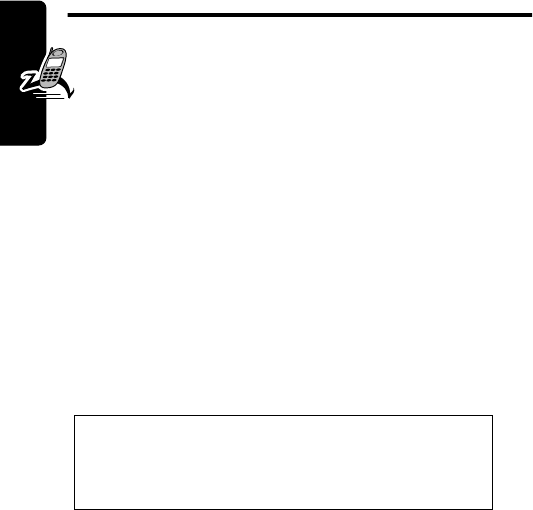
14
PRELIMINARY
Getting Started
Getting Started
What’s in the Box?
Your digital wireless phone typically comes equipped
with a battery and a charger. Other accessory options can
customize your phone for maximum performance and
portability.
To purchase Motorola Original™ accessories, contact the
Motorola Customer Call Center at 1-800-331-6456 in the
United States or 1-800-461-4575 in Canada.
About This Guide
This user guide introduces you to many of the most
popular features in your Motorola wireless phone.
To obtain the reference guide for your phone, or another
copy of this user guide, see the Motorola Web site at:
http://motorola.com/consumer/manuals
or contact the Motorola Customer Call Center at
1-800-331-6456 in the United States or 1-800-461-4575 in
Canada.
Note: A reference guide for your phone is
also available that describes less frequently
used phone features.
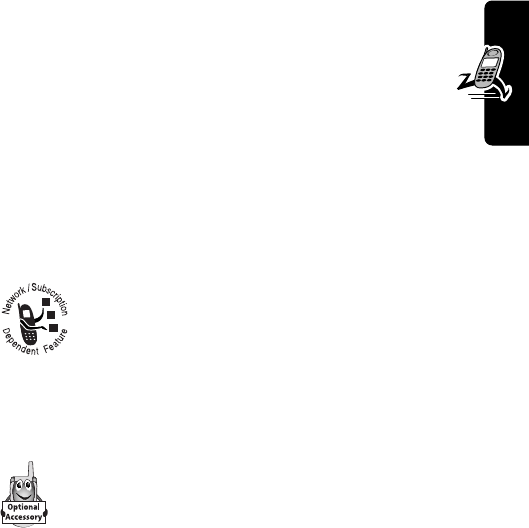
15
PRELIMINARY
Getting Started
Select a Menu Feature
Use the menu system to access your phone’s features.
This guide shows you how to select a menu feature as
follows:
This example shows that you must press
M
, scroll to and
select
Media Center
, then scroll to and select
Picture Viewer
.
Optional Features
This label identifies an optional network, SIM
card, or subscription-dependent feature that
may not be offered by all service providers in all
geographical areas. Contact your service
provider for more information.
Optional Accessories
This label identifies a feature that requires an
optional Motorola Original™ accessory.
Installing the SIM Card
Your SIM (Subscriber Identity Module) card contains your
phone number, service details, and phonebook/message
memory.
Find the Feature
M
>
Media Center
>
Picture Viewer
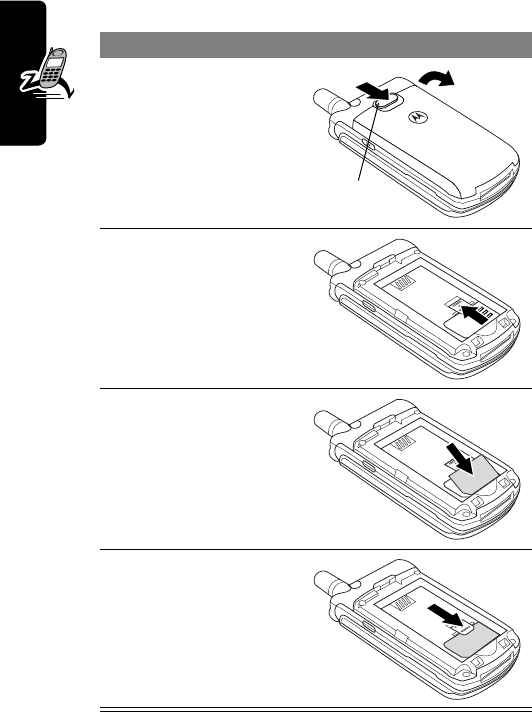
16
PRELIMINARY
Getting Started
Caution: Do not bend or scratch your SIM card. Avoid
exposing your SIM card to static electricity, water, or dirt.
Do This
1If necessary, slide
down the battery
door release latch
and lift the door off
of the phone.
2Slide the SIM card
latch up.
3Insert the SIM card
into the SIM card
tray with the notch
in the lower left
corner and the gold
plate facing down.
4Slide the SIM card
latch down to lock
the SIM card in
place.
Release
latch
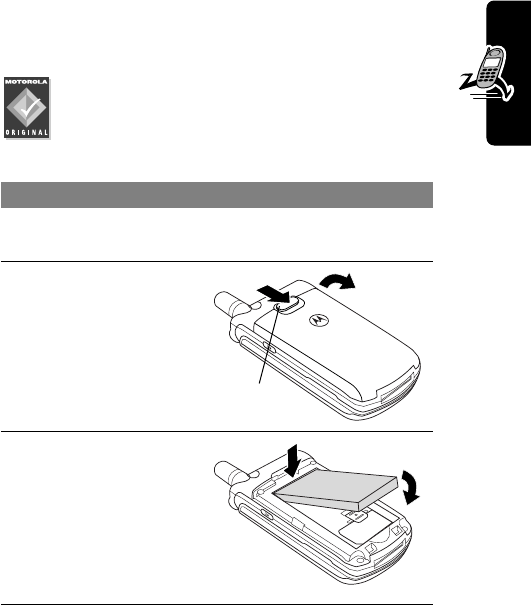
17
PRELIMINARY
Getting Started
Installing the Battery
You must install and charge the battery to use your
phone.
Your phone is designed to be used only with
Motorola Original batteries and accessories.
We recommend that you store batteries in their
protective cases when not in use.
Do This
1Remove the battery from its protective clear
plastic case.
2If necessary, slide
down the battery
door release latch
and lift the door off
of the phone.
3Insert the battery,
printed arrow first,
under the tab at
the top of the
battery
compartment and
push down.
Release
latch
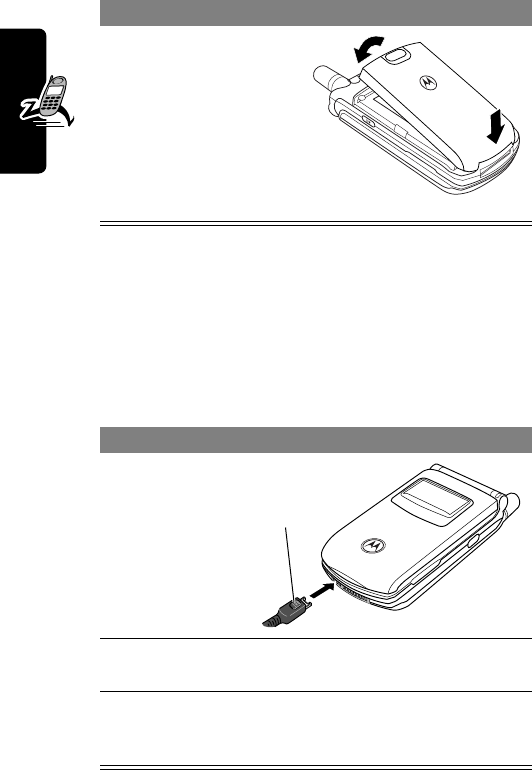
18
PRELIMINARY
Getting Started
Charging the Battery
New batteries are shipped partially charged. Before you
can use your phone, you need to install and charge the
battery, as indicated by the following instructions. Some
batteries perform best after several full charge/discharge
cycles.
4Insert the teeth at
the bottom of the
battery door into
the slot at the base
of the phone, then
push the door down
and snap it into
place.
Do This
1Plug the
travel
charger into
your phone
with the
release tab
facing up.
2Plug the other end of the travel charger into the
appropriate electrical outlet.
3When your phone indicates that the battery is
fully charged (
Charge Complete
), press the
release tab and remove the travel charger.
Do This
Release
tab

19
PRELIMINARY
Getting Started
Note: When you charge the battery, the battery level
indicator in the upper right corner of the display shows how
much of the charging process is complete.
Battery Use
Battery performance depends on many factors,
including your wireless carrier’s network configuration;
signal strength; the temperature at which you operate your
phone; the features and/or settings you select and use;
and your voice, data, and other application usage patterns.
Battery Care
Caution: To prevent injuries or burns, do not allow metal
objects to contact or short-circuit the battery terminals.
To maximize your battery’s performance:
•Always use Motorola Original™ batteries and battery
chargers. The phone warranty does not cover damage
caused from using non-Motorola batteries and/or
battery chargers.
•New batteries or batteries that have been stored for
long periods of time may require a longer charge time.
•Maintain the battery at or near room temperature
when charging.
•Do not expose batteries to temperatures below -10°C
(14°F) or above 45°C (113°F). Always take your
phone with you when you leave your vehicle.
•When you do not intend to use a battery for a while,
store it uncharged in a cool, dark, dry place, such as a
refrigerator.
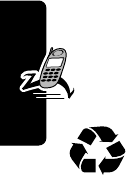
20
PRELIMINARY
Getting Started
•Over extended periods of time, batteries gradually
wear down and require longer charging times. This is
normal. If you charge your battery regularly and
notice a decrease in talk time or an increase in
charging time, then it is probably time to purchase
a new battery.
The rechargeable batteries that power this
product must be disposed of properly and may
need to be recycled. Refer to your battery’s label
for battery type. Contact your local recycling center for
proper disposal methods. Never dispose of batteries in a
fire because they may explode.
Extending Battery Life
• Turn off the status light
See page 36.
• Turn off the screen saver
Using an animated screen saver reduces your
phone’s talk and standby time.
• Minimize keypad-intense functions
Activities that require intensive keystroke use (such as
playing a game or using messaging) reduce your
phone’s talk and standby time.
• Turn off the display backlight
See page 27.
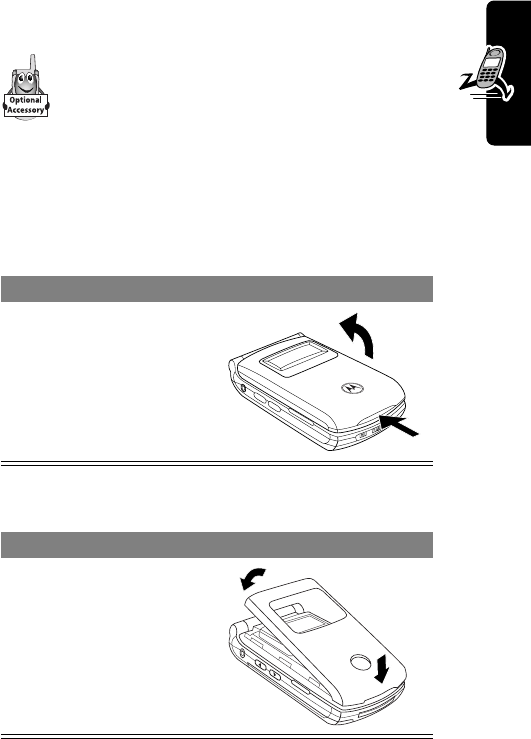
21
PRELIMINARY
Getting Started
Changing the Convertible
Covers
You can change the flip cover and battery cover
on your phone to personalize its appearance.
Matching front and back cover sets are
available in a variety of colors and designs.
Your phone is designed to be used only with Motorola
Original accessories. See your Motorola retailer for these
convertible covers.
To remove a flip cover:
To attach a flip cover:
Do This
Insert your fingernail into
the slot at the base of the
flip cover, then pull up
and lift the cover off the
phone
Do This
Insert the tabs at the
bottom of the new cover
into the slots at the base
of the phone, then push
the cover down and snap
it into place.
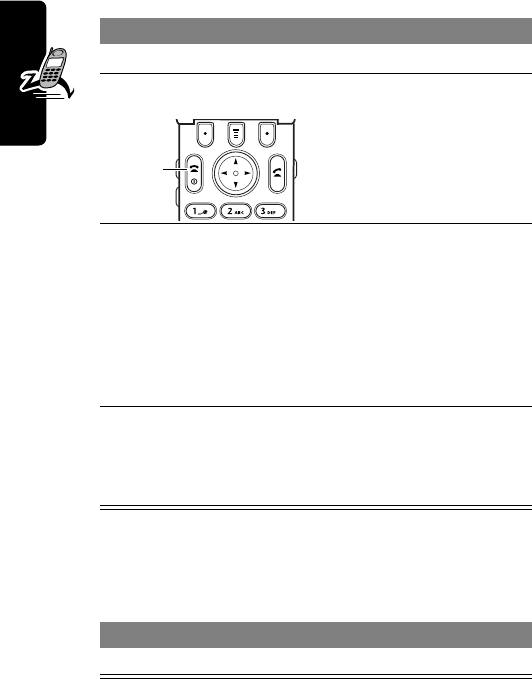
22
PRELIMINARY
Getting Started
Turning Your Phone On
Viewing Your Phone Number
From the idle display:
Do This To
1Open your phone expose the keypad
2Press and hold
P
turn on your phone
3If necessary, enter
your SIM card PIN
code and press
OK
(
+
)
unlock your SIM card
Caution: If you enter an
incorrect PIN code three
times in a row, your SIM
card is disabled and your
phone displays
SIM Blocked
.
4If necessary, enter
your four-digit
unlock code and
press
OK
(
+
)
unlock your phone
Press To
M
#
view your phone number
Power
key
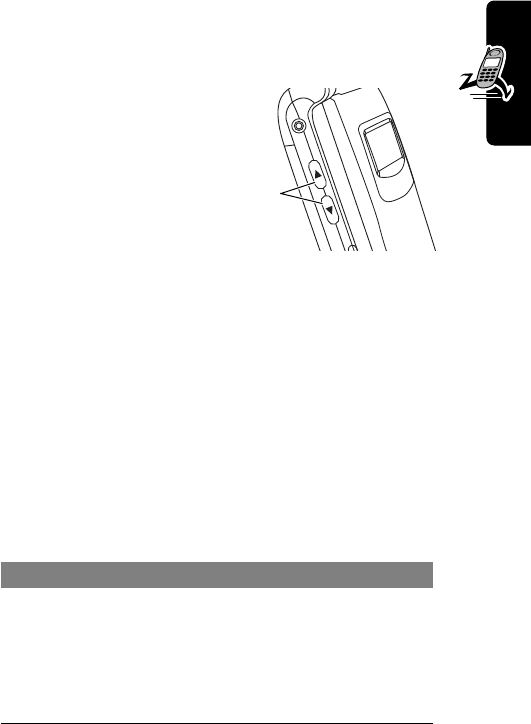
23
PRELIMINARY
Getting Started
Note: Your phone number must be stored on your SIM
card to use this feature. To store your phone number on
the SIM card, see page 36. If you do not know your
phone number, contact your service provider.
Adjusting
Volume
Press the up and
down volume keys to:
•increase and
decrease
earpiece volume during a call
•increase and decrease the ringer volume setting
when the idle display is visible (flip must be open)
Tip: At the lowest volume setting, press the down
volume key once to switch to vibrate alert. Press it
again to switch to silent alert. Press the up volume key
to cycle back to vibrate alert, then ring alert.
•turn off an incoming call alert
Making a Call
Press To
1keypad keys dial the phone number
Tip: If you make a mistake,
press
DELETE
(
-
) to delete the
last digit, or press and hold
DELETE
(
-
) to clear all digits.
Volume
keys
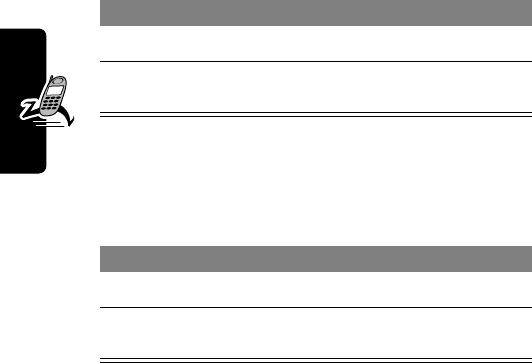
24
PRELIMINARY
Getting Started
Answering a Call
When you receive a call, your phone rings and/or vibrates
and displays an incoming call message.
Tip: When the phone flip is active, simply open the phone
to answer the call. (To activate, press
M
>
Settings
>
In-Call Setup
>
Answer Options
>
Open to Answer
)
Note: If the phone is locked, you must unlock it to answer
the call.
2
N
make the call
3
O
end the call and “hang up” the
phone when you are finished
Press To
1
N
or
ANSWER
(
+
)answer the call
2
O
end the call and “hang up” the
phone when you are finished
Press To
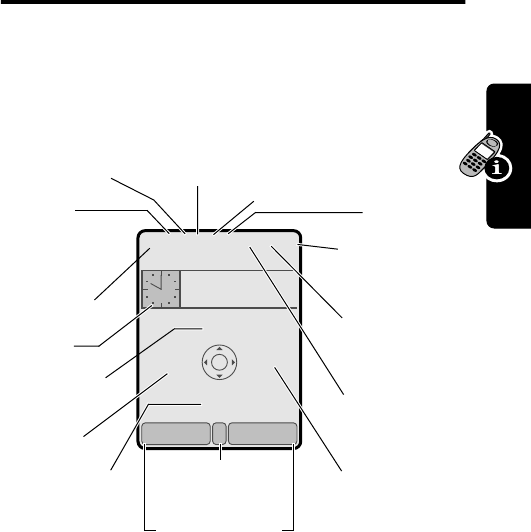
25
PRELIMINARY
Learning to Use Your Phone
Learning to Use Your
Phone
See page 1 for a basic phone diagram.
Using the Display
The
idle display
is the standard display that you see when
you are
not
on a call or using the menu.
Use the 4-way navigation key (
S
) to select one of the four
menu feature icons in the idle display. Labels at the bottom
Service Provider
10:00am
10/10/02
RECENTSTYLES e
bg
U
r
)
8
?
IP VQ
5^
➒
Message
Waiting
Indicator
Clock
➋
GPRS
Indicator
➊
Signal
Strength
Indicator
➐
Battery
Level
Indicator
➌
In Use
Indicator
➍
Roam
Indicator
➎
Active
Line
Indicator
➏
Text
Entry
Mode
Indicator
➑
Ring
Style
Indicator
➓
Menu
Indicator
Soft Key Labels
Messages
Phonebook Datebook
Web
Access
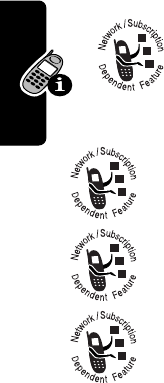
26
PRELIMINARY
Learning to Use Your Phone
corners of the display show the current soft key functions.
The menu indicator in the bottom center of the display
indicates that you can press
M
to go to the main menu to
see more features.
➊
Signal Strength Indicator Vertical bars show the
strength of the network connection. You cannot make or
receive calls when the
0
(no signal) indicator is displayed.
➋
GPRS Indicator Shows that your phone
is using a high-speed GPRS network
connection.
➌
In Use Indicator Shows that a call is in progress.
➍
Roam Indicator Shows that your phone is
seeking or using another network system
outside your home network.
➎
Active Line Indicator Shows the current
active phone line.
➏
Text Entry Mode Indicator Appears when
you are in a text entry screen, to show the
current active text entry mode.
➐
Battery Level Indicator Vertical bars show the battery
charge level. Recharge the battery when you see
Low Battery
and hear the low battery alert.
➑
Ring Style Indicator Shows the ring style setting.
V
= loud ring
W
= soft ring
Z
= vibrate
X
= vibrate and ring
Y
= silent
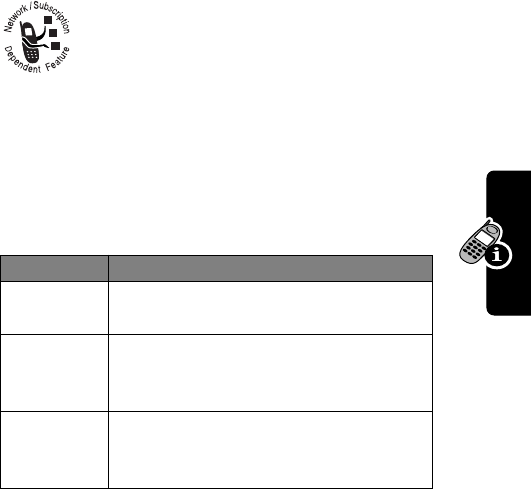
27
PRELIMINARY
Learning to Use Your Phone
➒
Message Waiting Indicator Appears when
you receive a text or email message.
➓
Menu Indicator Indicates that you can press
M
to go to
the main menu or open a feature sub-menu.
Display Settings
Note: See the reference guide for more information
about using these features.
Feature Description
Zoom Zoom in/out on primary display:
M
>
Settings
>
Initial Setup
>
Zoom
Contrast Set display contrast:
M
>
Settings
>
Initial Setup
>
Contrast
Backlight Adjust display and keypad backlights:
M
>
Settings
>
Initial Setup
>
Backlight

28
PRELIMINARY
Learning to Use Your Phone
Using Menus
Press
S
to highlight a menu feature icon in the main
menu. Select
?
(More) to see additional menu features.
The following icons represent features that may appear in
the main menu, depending on your service provider and
service subscription options.
EXIT SELECT
Main Menu
phonebook
Current selection.
End Key
Exit menu system
without making
changes, return
to idle display.
Left Soft Key
Perform function
shown in lower
left corner of
display (usually
EXIT
or
BACK
).
Menu Key
Enter menu system,
or open a sub-menu,
when
e
appears in
bottom center of
display.
4-Way
Navigation Key
Scroll
up
or
down
through menus
and lists. Scroll
left
or
right
to
cycle through
and set value of
highlighted menu
item. From idle
display, press
up
,
down
,
left
, or
right
to select menu
feature icon.
Right Soft Key
Perform function
shown in lower
right corner of
display (usually
SELECT
the
highlighted
menu item).
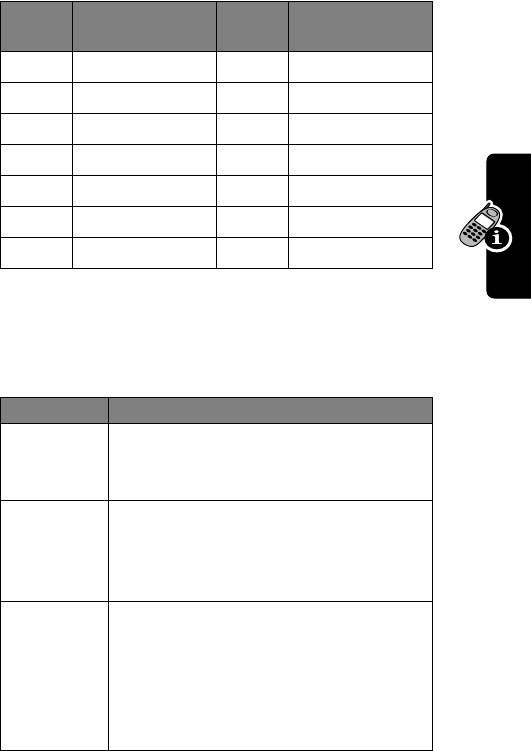
29
PRELIMINARY
Learning to Use Your Phone
Menu Settings
Note: See the reference guide for more information about
using these features.
Menu
Icon Feature Menu
Icon Feature
v
Media Center
-
Games & Apps
'
Voice Notes
:
Shortcuts
a
Calculator
/
Settings
r
Phonebook
b
Web Access
?
More
U
Messages
g
Datebook
z
Recent Calls
w
Ring Styles
9
Services
Feature Description
Language Set menu language:
M
>
Settings
>
Initial Setup
>
Language
Master
Reset Reset all options
except
unlock code,
security code, lifetime timer:
M
>
Settings
>
Initial Setup
>
Master Reset
Master
Clear Reset all options
except
unlock code,
security code, lifetime timer, clear all
user settings and entries
except
SIM
card information:
M
>
Settings
>
Initial Setup
>
Master Clear

30
PRELIMINARY
Learning to Use Your Phone
Entering Text
Multiple text entry methods make it easy for you to enter
names, numbers, and messages on your phone.
Choose a Text Mode
Press
M
>
Entry Method
from any text entry screen to
select a text mode:
Note: The text mode you select remains active until you
change it by selecting another mode.
Use Tap Method
This is the standard mode for entering text on your phone.
Press
M
>
Entry Method
from any text entry screen and
select the
Tap Method
menu option.
iTAP
Let the phone predict each word as you
enter it.
Tap Method
Enter letters, numbers, and symbols by
pressing a key one or more times.
Numeric
Enter numbers only.
Symbol
Enter symbols only.
Browse
Browse your phonebook or recent call
lists to select a name or number.
Press To
1A number key
one or more
times
select a letter, number, or
symbol shown in the
“Character Chart” on page 32
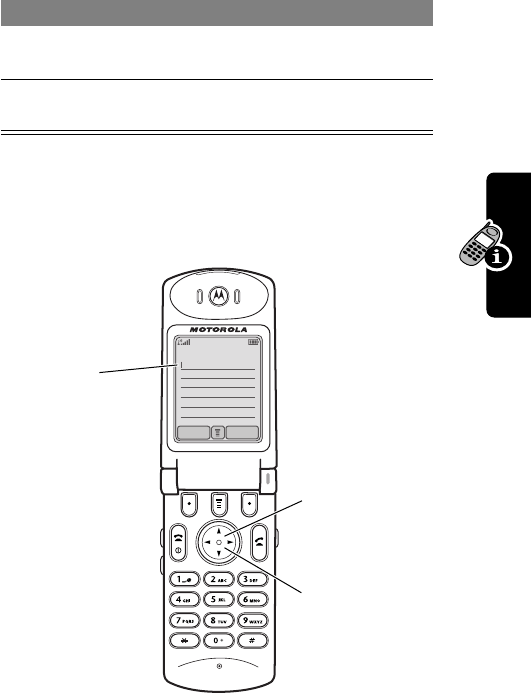
31
PRELIMINARY
Learning to Use Your Phone
General Text Entry Rules
Press a number key repeatedly to cycle through its
characters. See “Character Chart” on page 32.
2Number keys enter the remaining
characters
3
OK
(
+
) store the text when you are
finished
Press To
CANCEL BROWSE
MSG:
Press a number
key as many
times as
necessary
to enter the
desired
character at
flashing cursor
location.
Press and hold
a number key
to cycle
between text
entry modes.
Press
left
or
right
to move
flashing
cursor to the
left or right in
text message.
Press
up
or
down
to
change letter
in block cursor
to uppercase
or lowercase.
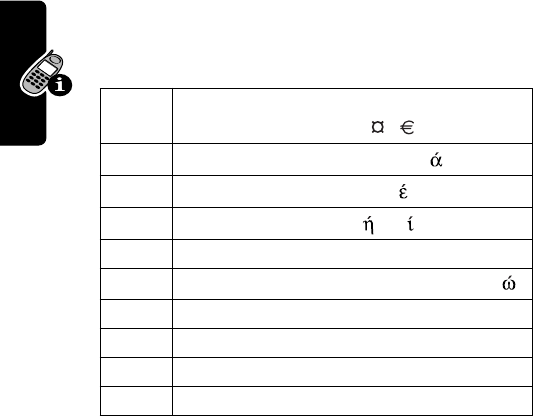
32
PRELIMINARY
Learning to Use Your Phone
•If you do not press a key for two seconds, the
character in the block cursor is accepted, and the
cursor moves to the next position.
•The first character of every sentence is capitalized.
(Press
S
down to force the character to lowercase
while it is highlighted by the block cursor.)
Character Chart
Use this chart as a guide for entering characters with
the tap method.
Note: This chart may not reflect the exact character set
available on your phone.
1
space
. 1 ? ! , @ _ & ~ : ; " -
( ) ' ¿ ¡ % £ $ ¥
2
a b c 2 ä å á à â ã α β ç
3
d e f 3 δ ë é è ê ε φ
4
g h i 4 ï í î
γ
η
ι
5
j k l 5 κ λ
6
m n o 6 ñ ö ø ó ò ô õ µ ν ω
7
p q r s 7 π ß σ
8
t u v 8 θ ü ú ù û τ
9
w x y z 9 ξ ψ
0
+ - 0 x * / \ [ ] = > < # §
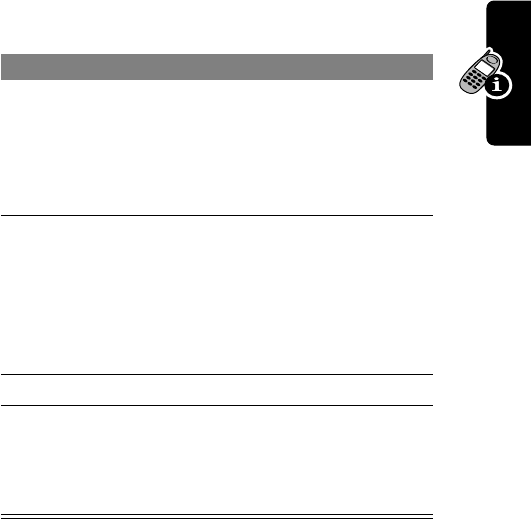
33
PRELIMINARY
Learning to Use Your Phone
Use iTAP™ Software Predictive Text Entry
Method
iTAP™ software provides a predictive text entry method
that lets you enter a word using one keypress per letter.
Press
M
>
Entry Method
from any text entry screen and
select the
iTAP
menu option.
Entering Words
Do This To
1Press a number
key one time enter the first letter of the
word
The letters associated with
the key are shown at the
bottom of the display.
2Press number
keys (one per
letter)
enter the rest of the word
Alternative words and letter
combinations are shown at
the bottom of the display. The
word choices are updated
with each keypress.
3Press
S
highlight the word you want
4Press
SELECT
(
+
)enter the word at the flashing
cursor location
A space is automatically
inserted after the word.
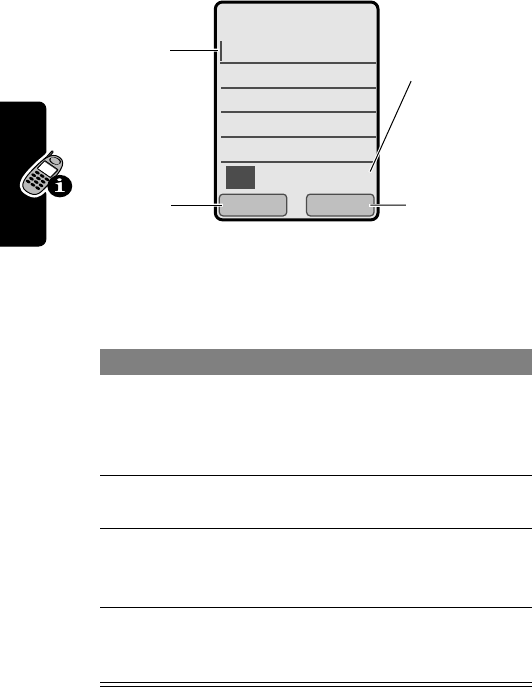
34
PRELIMINARY
Learning to Use Your Phone
For example, to spell the word “act,” press
2
2
8
.
The display shows:
Entering Novel Words
You may enter a word that the iTAP software does not
recognize. If the word is not displayed:
Do This To
1Press
DELETE
(
-
) one
or more times delete letters until you
see a letter combination
that matches the start of
the word
2Press
S
highlight the letter or
letter combination
3Press
SELECT
(
+
),
then press
S
to the
left
shift the text entry cursor
to the left and “lock” the
selected word portion
4Continue to enter
letters and highlight
letter combinations
spell the word
SELECTDELETE
Msg:
Act Cat Bat Abu }
Press
DELETE
(
-
)
to clear the
last letter.
Flashing
cursor
indicates
insertion
point.
Press
S
to
scroll and see
additional word
choices.
Press
SELECT
(
+
)
to insert the
highlighted
word.
5^
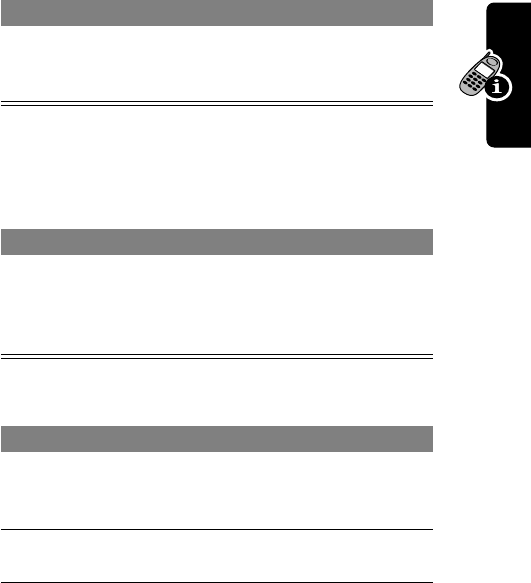
35
PRELIMINARY
Learning to Use Your Phone
Your phone stores the unrecognized word, and includes it
in the list of alternative word choices the next time you
enter it. When memory space for storing unrecognized
words is filled, your phone deletes the oldest words as new
words are added.
Entering Punctuation
Using Capitalization
The first word of a sentence is automatically capitalized,
with following words in lowercase.
Entering Numbers
Press To
1
or
0
enter punctuation or other
characters as shown in the
“Character Chart” on page 32
Press To
S
up or down change the words to initial
character capitalized, all
uppercase characters, or all
lowercase characters
Do This To
1Enter the first
digit and then
highlight it
put the iTAP software in
number entry mode
2Press number
keys add digits to the number
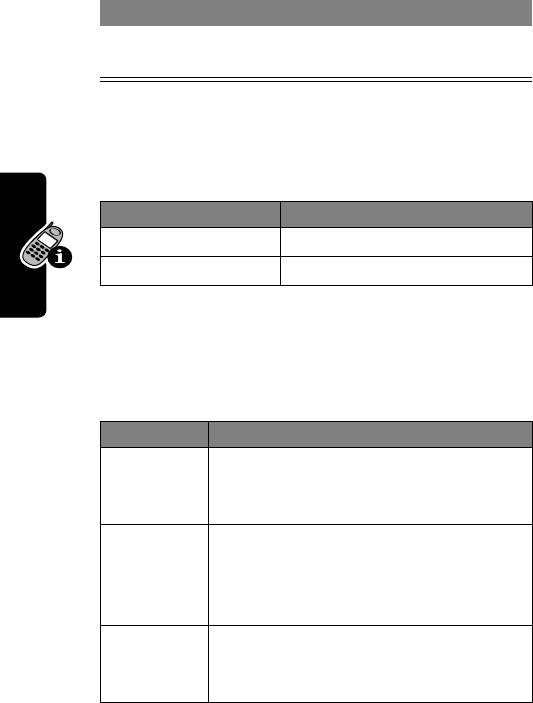
36
PRELIMINARY
Learning to Use Your Phone
Deleting Letters and Words
Place the cursor to the right of the text that you want to
delete, and then do the following:
Other Phone Features
Note: See the reference guide for more information about
using these features.
3Press
SELECT
(
+
) enter the number at the
flashing cursor location
Do This To
Press
DELETE
(
-
) delete one letter at a time
Hold
DELETE
(
-
) delete the entire message
Feature Description
Status
Light Turn on/off the status light:
M
>
Settings
>
Initial Setup
>
Status Light
Name &
Number Store your name and phone number
on your SIM card:
M
>
Settings
>
Phone Status
>
My Tel. Numbers
Time &
Date Set the time and date:
M
>
Settings
>
Initial Setup
>
Time and Date
Do This To
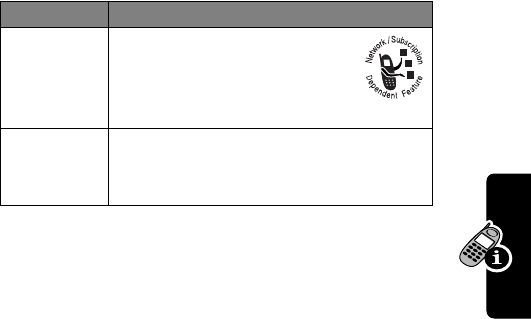
37
PRELIMINARY
Learning to Use Your Phone
Active
Line Change the active phone
line:
M
>
Settings
>
Phone Status
>
Active Line
Battery
Save Conserve battery power:
M
>
Settings
>
Initial Setup
>
Battery Save
Feature Description
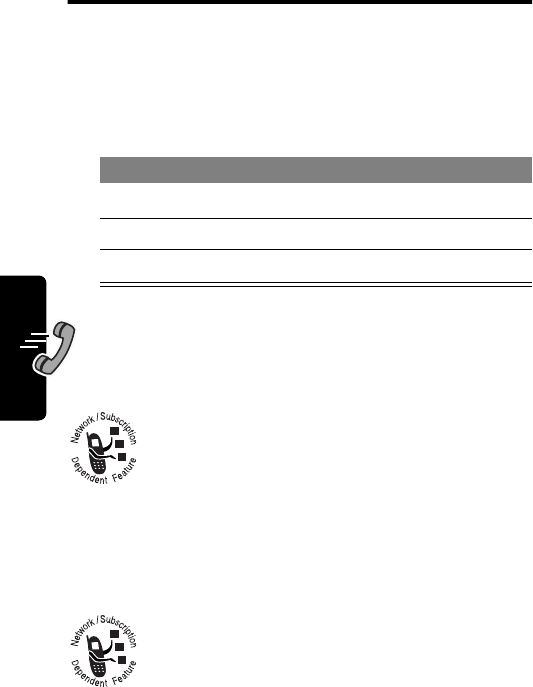
38
PRELIMINARY
Calling Features
Calling Features
For basic instructions on how to make a call and answer a
call, see page 23.
Redialing a Number
Using Caller ID
Incoming Calls
Calling line identification
(caller ID) displays the
phone number for incoming calls in your phone’s
external and internal displays.
Your phone displays the caller’s name when the
name is stored in your phonebook, or
Incoming Call
when
caller ID information is not available.
Outgoing Calls
You can show or hide your phone number as an
ID for the calls that you make.
Press To
1
N
view the dialed calls list
2
S
scroll to the entry you want to call
3
N
redial the number
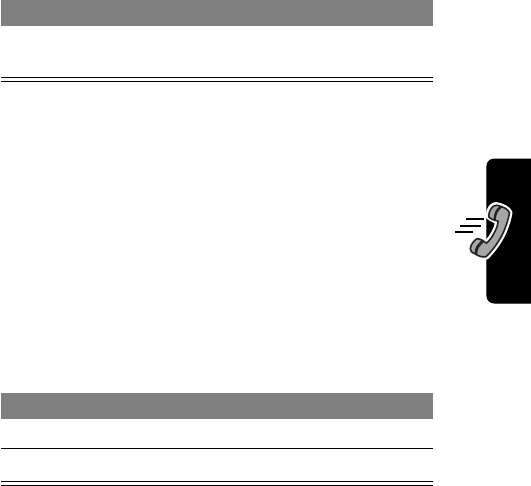
39
PRELIMINARY
Calling Features
You can override the default caller ID setting when you
make a call. While dialing (with digits visible in the display):
Calling an Emergency Number
Your service provider programs one or more emergency
phone numbers, such as 911, that you can call under
any circumstances, even when your phone is locked or
the SIM card is not inserted.
Note: Emergency numbers vary by country. Your
phone’s preprogrammed emergency number(s) may not
work in all locations, and sometimes an emergency call
cannot be placed due to network, environmental, or
interference issues.
Find the Feature
M
>
Settings
>
In-Call Setup
>
My Caller ID
Press To
M
>
Hide ID
/
Show ID
hide or show your caller ID for
the next call
Press To
1keypad keys dial the emergency number
2
N
call the emergency number
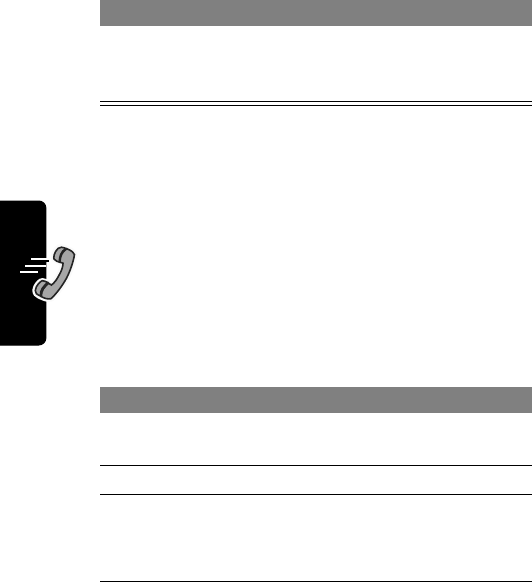
40
PRELIMINARY
Calling Features
Dialing an International
Number
To dial the local international access code:
Viewing Recent Calls
Your phone keeps lists of the calls you recently received
and dialed, even if the calls did not connect. The lists are
sorted from newest to oldest entries. The oldest entries
are deleted as new ones are added.
Shortcut: Press
N
to go directly to the dialed calls list
from the idle display.
Do This To
Press and
hold
0
insert the international access
code (
+
) for the country from
which you are calling
Find the Feature
M
>
More
>
Recent Calls
Press To
1
S
scroll to
Received Calls
or
Dialed Calls
2
SELECT
(
+
) select the list
3
S
scroll to an entry
Note:
<
means the call
connected.
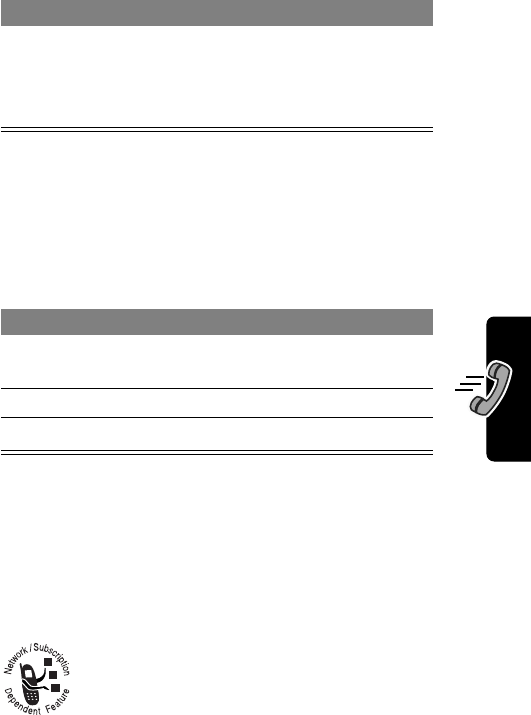
41
PRELIMINARY
Calling Features
Calling With Speed Dial
Each entry you store in your phonebook is assigned a
unique
speed dial
number that identifies the location
where the entry is stored in phone memory or on the SIM
card. To speed dial a phonebook entry:
Calling With 1-Touch Dial
To call phonebook entries 1 through 9, just press and hold
the one-digit speed dial number for one second.
Using Voicemail
You can listen to your voicemail messages by
calling your network voicemail phone number.
Voicemail messages are stored on the
network—not on your phone.
4
N
or
VIEW
(
+
)
call the entry’s number
view entry details
Press To
1keypad keys enter the speed dial number
for the entry you want to call
2
#
submit the number
3
N
call the entry
Press To
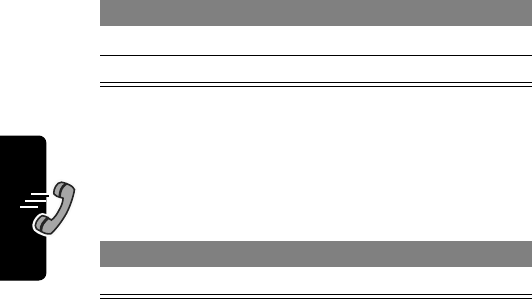
42
PRELIMINARY
Calling Features
Store Your Voicemail Number
Storing your voicemail number in your phone makes it
easy for you to listen to new voicemail messages. In many
cases, your service provider has already done this for you.
Receive a Voicemail Message
When you receive a voicemail message, your phone
displays the
&
(voice message waiting) indicator and
a
New VoiceMail
notification.
Listen to a Voicemail Message
The phone calls your voicemail number. If no voicemail
number is stored, your phone prompts you to store one.
Find the Feature
M
>
More
>
Messages
M
>
VoiceMail Setup
Press To
1keypad keys enter your voicemail number
2
OK
(
+
) store the number
Press To
CALL
(
+
) listen to the message
Find the Feature
M
>
More
>
Messages
>
VoiceMail
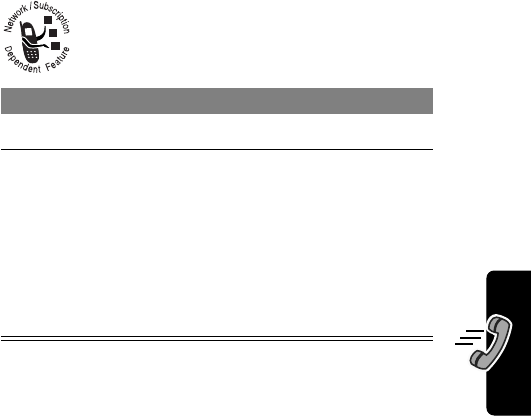
43
PRELIMINARY
Calling Features
Using Call Waiting
When you are on a call, an alert tone sounds to
indicate that you have received a second call.
You must turn on call waiting to use the feature. To turn
call waiting on or off:
Press To
1
N
answer the new call
2
SWITCH
(
+
)
or
LINK
(
-
)
or
M
>
End Call On Hold
switch between calls
connect the two calls
end the call on hold
Find the Feature
M
>
Settings
>
In-Call Setup
>
Call Waiting
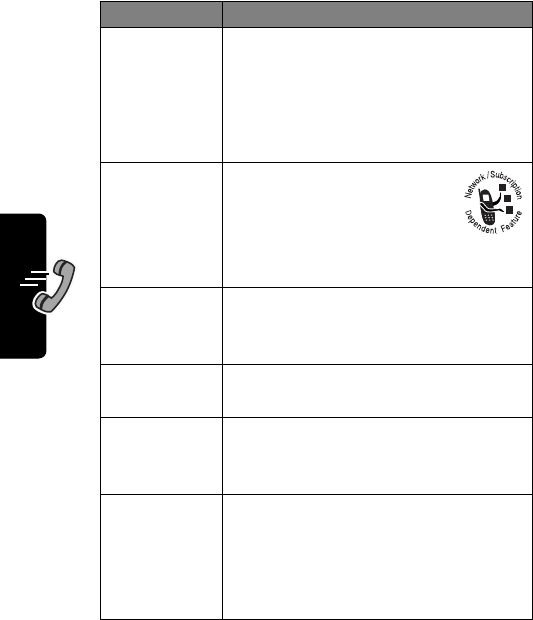
44
PRELIMINARY
Calling Features
Other Calling Features
Note: See the reference guide for more information about
using these features.
Feature Description
View Your
Phone
Number
During a call:
M
>
My Tel. Numbers
Note: Your phone number must be
stored on your SIM card to use this
feature. See page 36.
Automatic
Redial Automatically redial calls
that fail due to busy
conditions:
M
Settings
>
Initial Setup
>
Auto Redial
Cancel
Incoming
Call
While phone is ringing or vibrating:
Press
O
or
IGNORE
(
-
)
Turn Off Call
Alert While phone is ringing or vibrating:
Press either volume key
Notepad Retrieve the last number entered on
the keypad:
M
>
More
>
Recent Calls
>
Notepad
Attach
Number While dialing (digits visible in
display):
M
>
Attach Number
to attach a number from the
phonebook or recent call lists
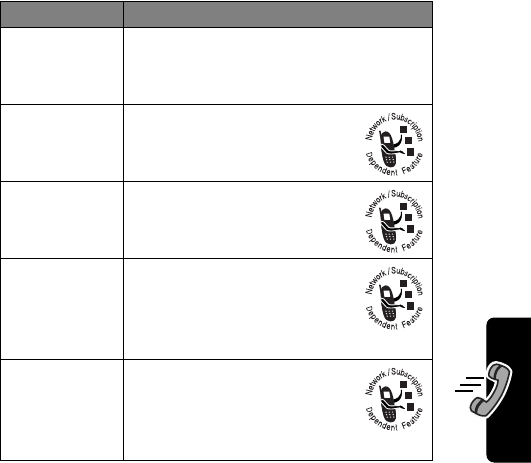
45
PRELIMINARY
Calling Features
Hold Call During a call:
Press
HOLD
(
+
) (if available) or
M
>
Hold
Transfer
Call During a call:
M
>
Transfer
, dial the
number, press
N
Conference
Call During a call:
M
>
Hold
, dial next number,
press
N
, press
LINK
(
-
)
Call
Forwarding Set up or cancel call
forwarding:
M
>
Settings
>
Call Forward
Call Barring Restrict outgoing or
incoming calls:
M
>
Settings
>
Security
>
Call Barring
Feature Description

46
PRELIMINARY
Messages and Chat
Messages and Chat
Text messages are brief messages that you can
send and receive.
Quick notes are pre-written text messages that
you can insert into a message and send quickly.
Note: Your text message inbox must be set up
before
you
can send and receive messages. In many cases, your
service provider has already set up the text message inbox
for you. If necessary, see the reference guide for text
message inbox setup instructions.
Sending a Text Message
You can send a text message to one or more recipients.
You can manually enter each recipient’s phone number or
email address, or select numbers/addresses from the
phonebook or recent call lists.
Note: When you manually enter numbers and/or email
addresses, you must insert a space between each
entry. Press
S
to the right to insert a space.
Shortcut: Enter a phone number in the idle display, then
press
M
>
Send Message
to open a new text message with
the number in the
To
field. Go directly to step 4 to continue.
Find the Feature
M
>
More
>
Messages
>
Create Message
Press To
1
CHANGE
(
+
) select
To
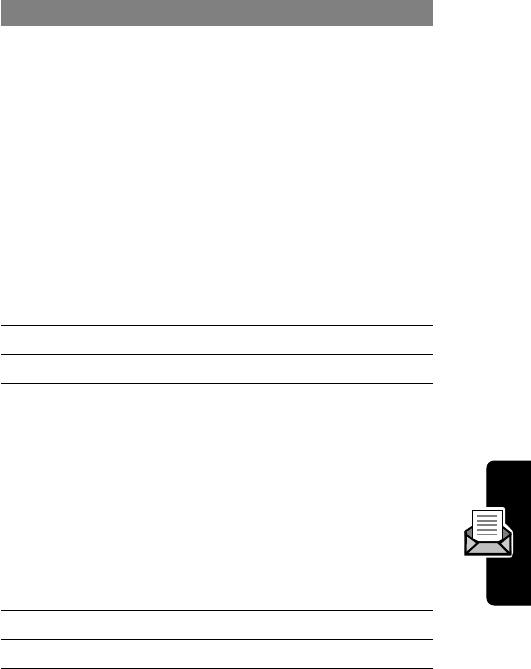
47
PRELIMINARY
Messages and Chat
2keypad keys
or
BROWSE
(
+
)
enter one or more phone
numbers and/or email
addresses
Tip: Press
S
to the right to
insert a space between each
number/address that you
enter manually.
select numbers/addresses
from the phonebook or recent
call lists
3
OK
(
+
) store the recipient list
4
CHANGE
(
+
) select
Msg
5keypad keys
or
BROWSE
(
+
)
enter the message (see
page 30)
Tip: Press
M
to change text
entry mode, or to insert
images or sounds in the
message.
insert a quick note
6
OK
(
+
) store the message
7
DONE
(
-
) finish the message
Press To
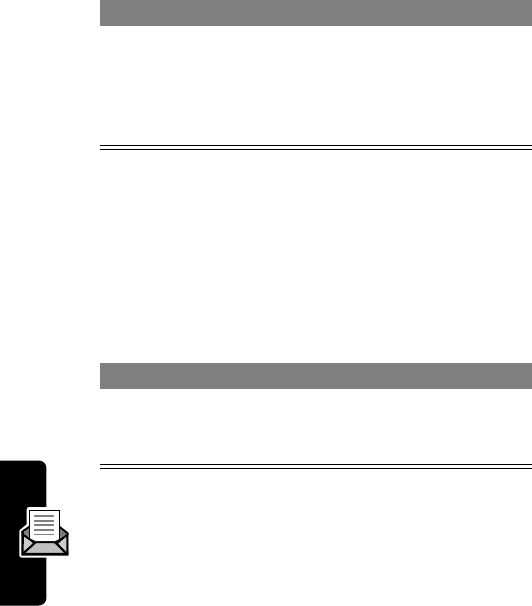
48
PRELIMINARY
Messages and Chat
Receiving a Text Message
Note: Your text message inbox must be set up before you
can receive text messages.
When you receive a text message, your phone displays the
X
(message waiting) indicator and a
New Message
notification, and gives an alert.
If reminders are turned on, your phone sends a
reminder at regular intervals until you close the new
message notification, read the message, or turn off
your phone.
When your phone displays
Memory is Full!
, you must
delete some existing messages from your inbox, outbox, or
drafts folder to receive new messages.
8
YES
(
-
)
or
NO
(
+
)
send the message
cancel the message or save it
as a draft.
Press To
READ
(
+
) open the message (or your
text message inbox if there
are multiple messages)
Press To
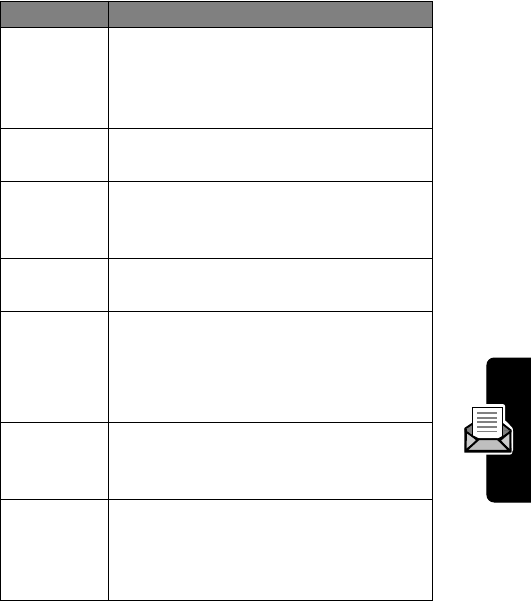
49
PRELIMINARY
Messages and Chat
Other Message Features
Note: See the reference guide for more information about
using these features.
Feature Description
Inbox
Setup Set up or edit the text message inbox
settings:
M
>
More
>
Messages
M
>
Text Msg Setup
Quick
Note Send or create a quick note message:
M
>
More
>
Messages
>
Quick Notes
Insert
Pictures &
Sounds
While composing a message:
M
>
Insert
Sent
Messages View sent messages:
M
>
More
>
Messages
>
Outbox
Received
Messages Read received messages:
M
>
More
>
Messages
>
Text Msgs
Tip: Press
M
to perform various
operations on the selected message.
Store
Pictures &
Sounds
Highlight a picture or sound in a
message, then:
M
>
Store
Browser
Alerts Read alert messages received by your
micro-browser:
M
>
More
>
Messages
>
Browser Alerts
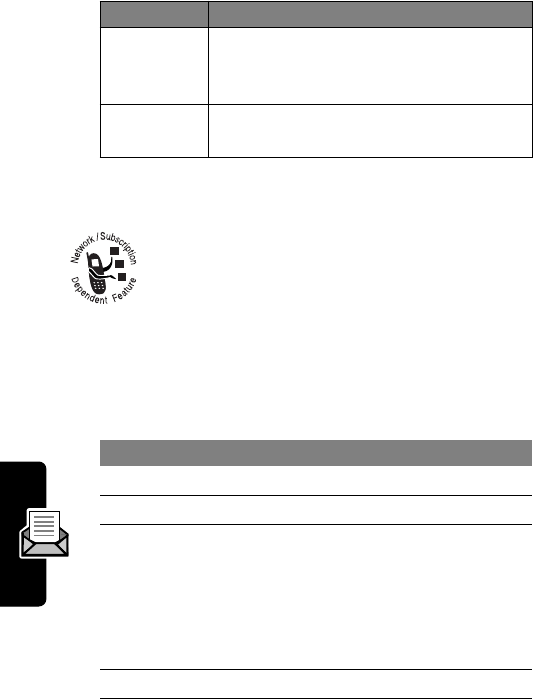
50
PRELIMINARY
Messages and Chat
Using Chat
You can exchange text messages in real time
with another wireless phone user in a
chat
session
. The messages you send appear
immediately on your chat partner’s phone.
Start a Chat Session
Info
Services Read subscription-based information
services messages:
M
>
More
>
Messages
>
Info Services
Drafts View messages saved in drafts folder:
M
>
More
>
Messages
>
Drafts
Find the Feature
M
>
Chat
M
>
New Chat
Press To
1keypad keys enter your
Chat Name
2
OK
(
+
) save your
Chat Name
3keypad keys
or
BROWSE
(
+
)
enter your chat partner’s
phone number
select a number from the
phonebook or recent call lists
4
OK
(
+
) store the number
Feature Description
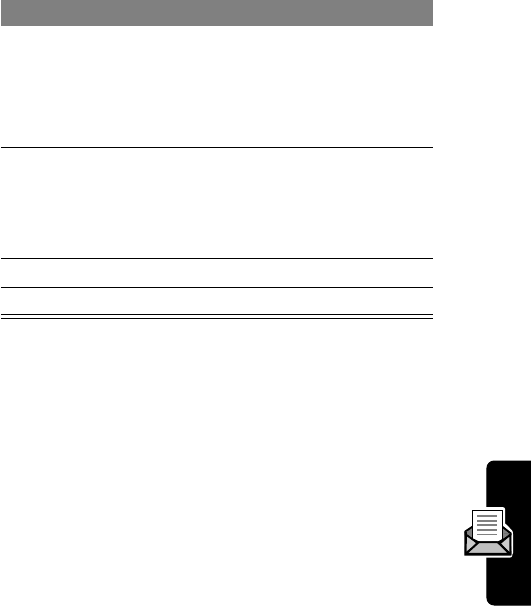
51
PRELIMINARY
Messages and Chat
Notes:
•You can start a chat session from a text message.
Press
M
and select
Chat
to start a new session with
the sender’s
Reply To
number in the
To
field.
•When your phone displays
Memory is Full!
, you must
delete some existing messages from your inbox,
outbox, or drafts folder to receive new chat
messages.
5keypad keys
or
BROWSE
(
+
)
enter your first chat message
(see page 30)
insert a quick note
6
OK
(
+
) send the chat message
When your chat partner
replies, the reply appears
below your text.
7
CHAT
(
+
) enter a reply to your partner
8
OK
(
+
) send your reply
Press To
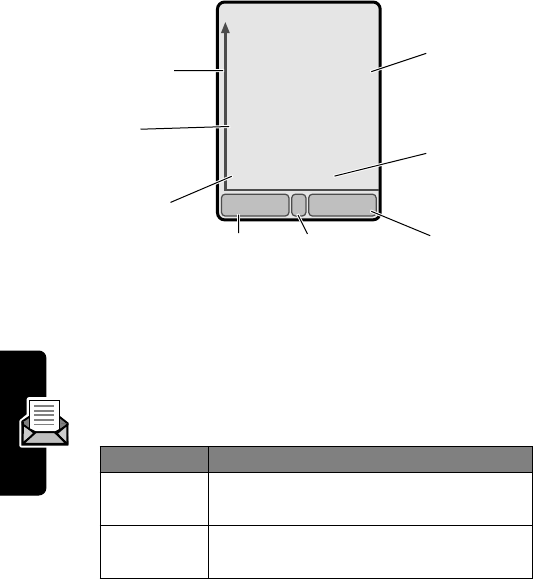
52
PRELIMINARY
Messages and Chat
Use the Chat Log
The chat log displays the messages exchanged in a chat
session.
Other Chat Features
Note: See the reference guide for more information
about using these features.
Feature Description
Respond
to Chat When you receive a chat message:
Press
ACCEPT
(
+
) or
IGNORE
(
-
)
End Chat During a chat session:
M
>
End Chat
wanted to know if
you will be there
today
Carlo>What time
does it start?
>>Katy>10 AM
CHATEXIT e
5E
Enter
reply
Exit
chat
Press
M
to open the
Chat Menu
Chat
text
Chat
name
Message
Status:
>>
sending
m
failed
Press
S
to scroll
and see
more text.
Newest
messages
appear at
bottom of
log.

53
PRELIMINARY
Email
Email
You can send and receive email messages from
your phone. New email messages that you
receive are stored on your service provider’s
email server until you download them to your
phone.
Note: Your email message inbox must be set up
before
you can send and receive email messages. In many
cases, your service provider has already set up the email
inbox for you. If necessary, see the reference guide for
email inbox setup instructions.
Sending an Email Message
You can send an email message to one or more recipients.
You can manually enter each recipient’s email address, or
select addresses from the phonebook.
Note: When you manually enter email addresses, you
must insert a space, comma, semicolon, or colon
between each address. Press
S
to the right to insert
a space.
Find the Feature
M
>
More
>
Messages
>
Email Msgs
M
>
Create Email
Press To
1
CHANGE
(
+
) select
To
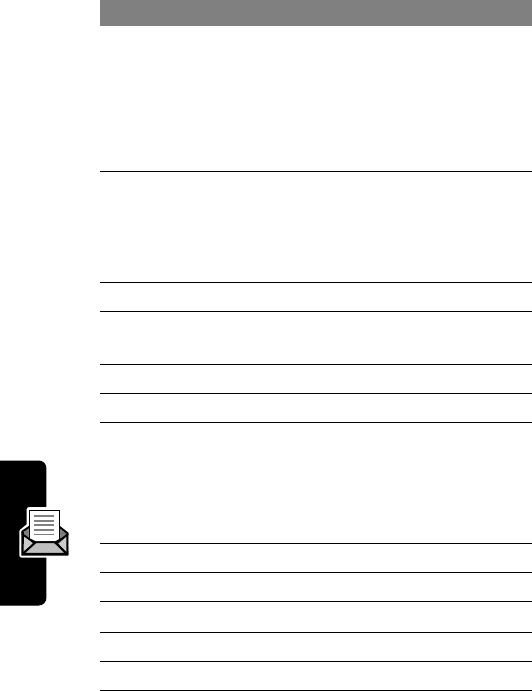
54
PRELIMINARY
Email
2keypad keys
or
BROWSE
(
+
)
enter one or more email
addresses
select addresses from the
phonebook
3
OK
(
+
) store the address(es)
Repeat steps 1 to 3 to store
email addresses in the
cc
and
bcc
fields, if desired
4
CHANGE
(
+
) select
Subject
5keypad keys enter the subject (see
page 30)
6
OK
(
+
) store the subject
7
CHANGE
(
+
) select
Msg
8keypad keys
or
BROWSE
(
-
)
enter the message (see
page 30)
insert a quick note
9
OK
(
+
) store the message
10
CHANGE
(
+
) select
Priority
11
S
scroll to
Normal
or
Urgent
12
SELECT
(
+
) set the priority
13
DONE
(
-
) finish the message
Press To

55
PRELIMINARY
Email
Receiving an Email Message
Note: Your email inbox must be set up before you can
receive email messages.
If your phone is set up to periodically check for new email
messages, your phone displays the
X
(message waiting)
indicator and a
New Message
notification, and gives an
alert when you receive an email message.
If reminders are turned on, your phone sends a
reminder at regular intervals until you close the new
message notification, read the message, or turn off
your phone.
When your phone displays
Memory is Full!
, you must
delete some existing messages from your inbox, outbox, or
drafts folder to receive new messages.
14
YES
(
-
)
or
NO
(
+
)
send the message
cancel the message or save it
as a draft
Press To
READ
(
+
) open the message (or your
email inbox if there are
multiple messages)
Press To
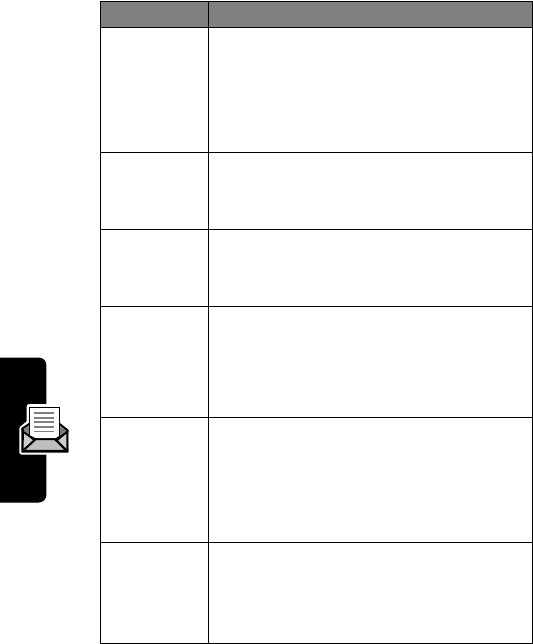
56
PRELIMINARY
Email
Other Email Features
Note: See the reference guide for more information about
using these features.
Feature Description
Email
Inbox
Setup
Set up or edit the email message inbox
settings:
M
>
More
>
Messages
>
Email Messages
M
>
Email Msg Setup
Insert
Quick
Note
Insert a quick note into the email
Msg
body:
Press
BROWSE
(
+
)
Sent Email
Messages View sent email messages:
M
>
More
>
Messages
>
Email Msgs
>
Outbox
Received
Email
Messages
Read received email messages:
M
>
More
>
Messages
>
Email Msgs
Tip: Press
M
to perform various
operations on the selected message.
Manually
Send &
Receive
Manually send and receive email
messages:
M
>
More
>
Messages
>
Email Messages
M
>
Send/Receive Mail
Folders Create personal folders to organize
your email messages:
M
>
More
>
Messages
>
Email Msgs
>
Folder
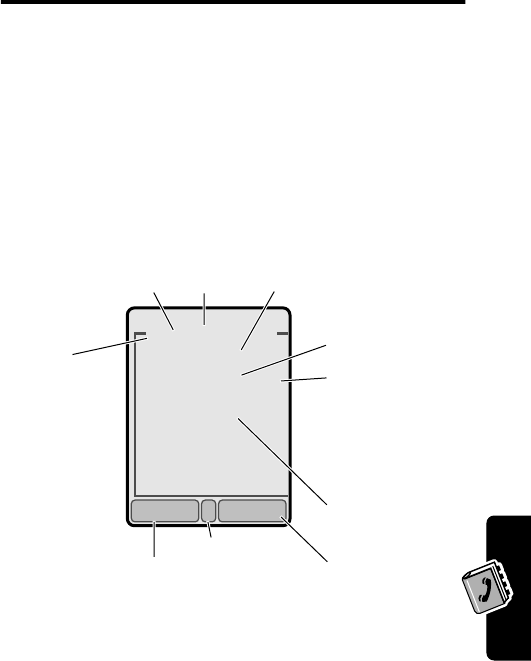
57
PRELIMINARY
Setting Up Your Phonebook
Setting Up Your
Phonebook
You can store a list of names and phone numbers or email
addresses in your phone’s electronic phonebook.
To see the names in your phonebook, press
M
>
Phonebook
from the idle display. Scroll to a name and press
VIEW
(
+
)
to view details of the phonebook entry as shown below.
Viewing Entry Details
*Carlo Emrys
01543372151410
Speed No. 15# (P)
Ringer ID:Contin...
EDITBACK e
5E
$
Type
indicator
identifies
number
type:
$
Work
U
Home
S
Main
h
Mobile
Z
Fax
p
Pager
[
Email
Entry’s
Name
Return
to list
Entry’s speed
dial number
(P)
indicates
entry stored
in phone
memory,
(S)
indicates
SIM memory
Voice Name
indicator
indicates a recorded
voice name
Entry’s
phone number
or
email address
Entry’s ringer
ID setting
Press
M
to open the
Phonebook
Menu
Edit entry
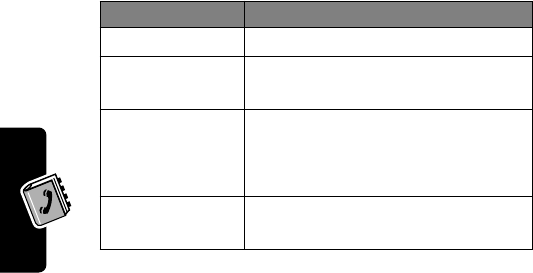
58
PRELIMINARY
Setting Up Your Phonebook
Note: Entries stored on the SIM card do not have
Type
,
Voice Name
, or
Ringer ID
information.
Creating a Phonebook Entry
You can store an entry on your phone or on the SIM card.
Enter Information
To create or edit a phonebook entry:
Shortcut: Enter a phone number in the idle display, then
press
STORE
(
+
) to create a phonebook entry with the
number in the
No.
field.
A phone number or email address is required for a
phonebook entry. All other information is optional. You can
enter the following information for a phonebook entry.
Find the Feature
M
>
More
>
Phonebook
M
>
New
>
Phone Number
or
Email Address
Item Description
Name
entry name (see page 30)
No.
or
Email
entry’s phone number or email
address (see page 30)
Type
entry type
Note: This option is not available
for entries stored on the SIM card.
Store To
entry’s physical storage location
(
Phone
or
SIM
)
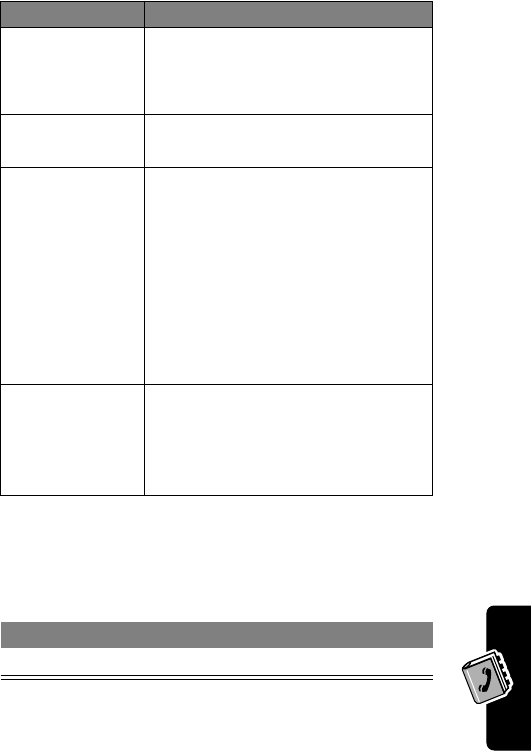
59
PRELIMINARY
Setting Up Your Phonebook
Complete Phonebook Entry
When you are finished entering information for a
phonebook entry:
Voice Name
record a voice name for the entry
Note: This option is not available
for entries stored on the SIM card.
Speed No.
entry’s default speed dial number
(select to change)
Ringer ID
select to set a distinctive ringer
alert for the phone number
Your phone uses the alert to notify
you when you receive a call from
this phone number. To activate
ringer IDs, see page 65.
Note: This option is not available
for entries stored on the SIM card.
MORE
create another entry under the
same
Name
You must use a different
Type
identifier for each number.
Press To
DONE
(
-
) store the entry
Item Description
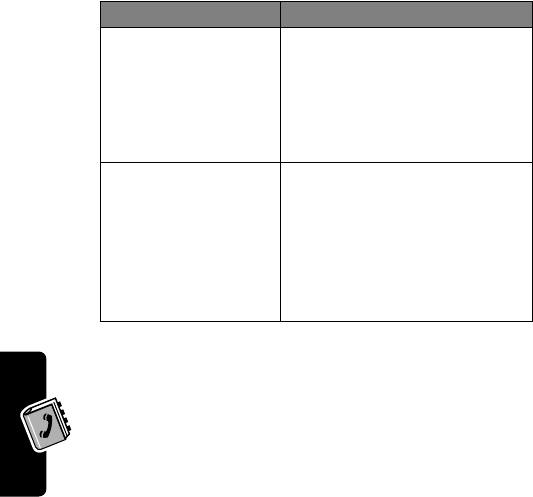
60
PRELIMINARY
Setting Up Your Phonebook
Storing a PIN Code With the
Phone Number
You can store a PIN code with the phone number for calls
that require additional digits (for example, to make a calling
card call, or to retrieve voicemail or answering machine
messages). Insert one or more of the following characters
in the dialing sequence to ensure that the number dials
and connects properly:
Press To
M
>
Insert Pause
insert a
p
(pause) character
Your phone dials the
preceding digits, waits for the
call to connect, then sends
the remaining digit(s).
M
>
Insert Wait
insert a
w
(wait) character
Your phone dials the
preceding digits, waits for the
call to connect, then prompts
you for confirmation before it
sends the remaining digit(s).

61
PRELIMINARY
Setting Up Your Phonebook
Recording a Voice Name For a
Phonebook Entry
You can record a voice name for a new or existing
phonebook entry. A voice name lets you call the
phonebook entry using voice dial (see page 63).
Note: You cannot record a voice name for an entry stored
on the SIM card.
Tip: Make your recording in a quiet location. Hold the
phone about four inches (10 centimeters) from your mouth,
and speak directly into the phone in a normal tone of voice.
M
>
Insert 'n'
insert an
n
(number)
character
Your phone prompts you for a
number before dialing the
call. The number you enter is
inserted into the dialing
sequence in place of the
n
character
Find the Feature
M
>
More
>
Phonebook
Do This To
1Press
S
scroll to the entry
2Press
VIEW
(
+
) view entry details
3Press
EDIT
(
+
) edit the entry
4Press
S
scroll to
Voice Name
5Press
RECORD
(
+
) begin recording
Press To
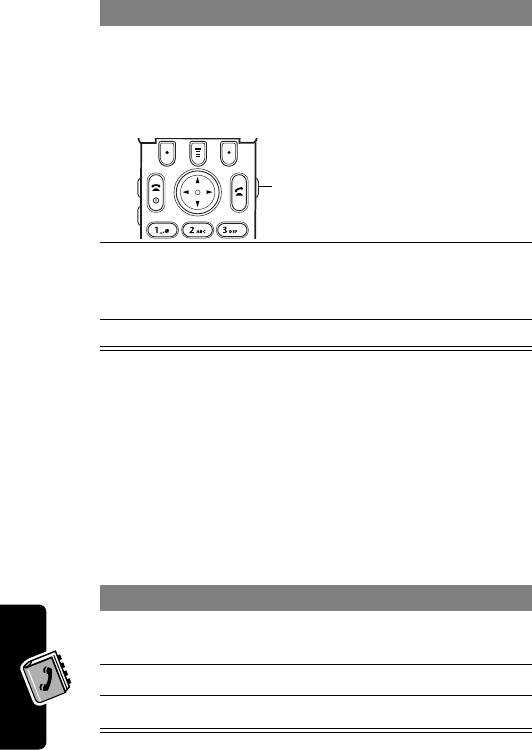
62
PRELIMINARY
Setting Up Your Phonebook
Dialing a Phonebook Entry
Use one of the following procedures to call a number (or
send a text message to an email address) stored in your
phonebook.
Phonebook List
6Press and release the
voice key and say the
entry’s name (in two
seconds)
record the voice
name
7Press and release the
voice key and repeat the
name
confirm the voice
name
8Press
DONE
(
-
) store the voice name
Find the Feature
M
>
More
>
Phonebook
Press To
1keypad key letter jump to entries that begin
with that letter (optional)
2
S
scroll to the entry
3
N
make the call
Do This To
Voice
key
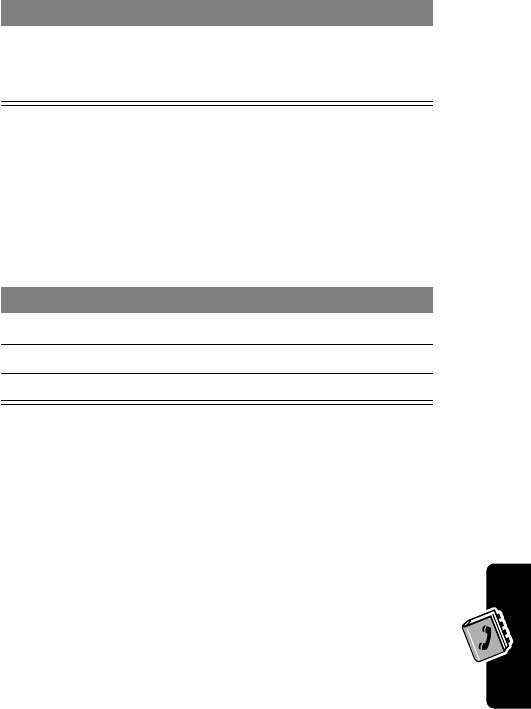
63
PRELIMINARY
Setting Up Your Phonebook
Voice Dial
To speed dial a phonebook entry, see page 41. To call an
entry with 1-touch dial, see page 41.
Editing a Phonebook Entry
Edit the entry information described on pages 58-59.
Tip: Press
M
to open the
Phonebook Menu
to perform
various operations on the selected entry.
Do This To
Press and release the voice
key and say the entry’s name
(in two seconds).
make the call
Find the Feature
M
>
More
>
Phonebook
Press To
1
S
scroll to the entry
2
VIEW
(
+
) view entry details
3
EDIT
(
+
) edit the entry

64
PRELIMINARY
Personalizing Your Phone
Personalizing Your
Phone
Setting a Ring Style
Your phone rings or vibrates to notify you of an incoming
call or other event. This ring or vibration is called an
alert
.
You can select one of five different ring styles:
The ring style indicator in the display shows the current
ring style (see page 25).
Each ring style contains settings for specific event alerts,
ringer ID, and ringer and keypad volume.
w
= loud ring
x
= soft ring
y
= vibrate
u
= vibrate and ring
t
= silent
Find the Feature
M
>
More
>
Ring Styles
>
Style
Press To
1
S
scroll to the ring style
2
SELECT
(
+
) select the ring style
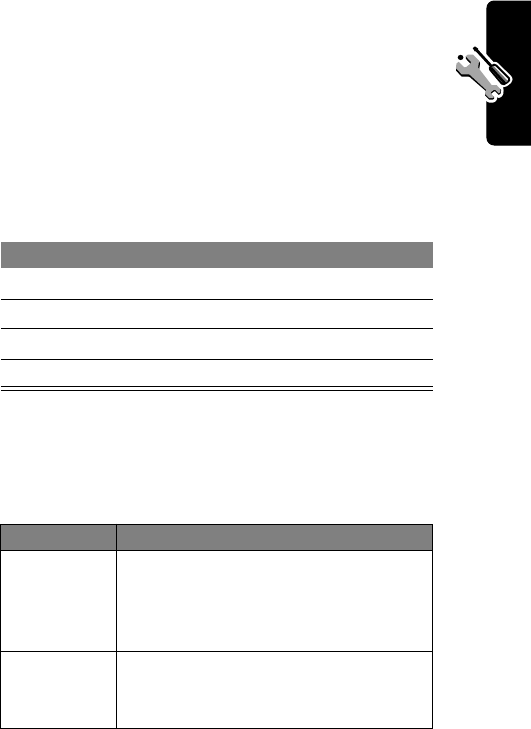
65
PRELIMINARY
Personalizing Your Phone
Personalizing a Ring Style
You can change the alerts that notify you of the
following events: incoming calls, text messages,
voicemail messages, data calls, fax calls, alarms, and
reminders. Any changes you make are saved to the
current ring style.
Note:
Style
represents the current ring style.
Other Personalization Features
Note: See the reference guide for more information about
using these features.
Find the Feature
M
>
More
>
Ring Styles
>
Style
Detail
Press To
1
S
scroll to the event
2
CHANGE
(
+
) select the event
3
S
scroll to the alert you want
4
SELECT
(
+
) select the alert
Feature Description
Ringer IDs Activate distinctive ringer alerts for
phonebook entries (see page 59):
M
>
More
>
Ring Styles
>
Style
Detail
>
Ringer IDs
Ring
Volume Adjust ringer volume:
M
>
More
>
Ring Styles
>
Style
Detail
>
Ring Volume
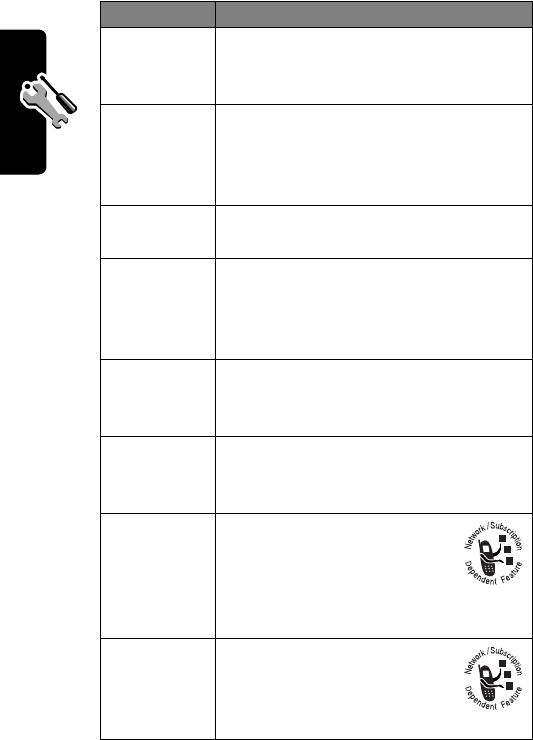
66
PRELIMINARY
Personalizing Your Phone
Keypad
Volume Adjust keypad keypress volume:
M
>
More
>
Ring Styles
>
Style
Detail
>
Key Volume
Reminders Set reminder alerts for voicemail, text,
email, or chat messages you receive:
M
>
More
>
Ring Styles
>
Style
Detail
>
Reminders
My Tones Create custom alert tones:
M
>
Media Center
>
My Tones
Wallpaper Set a wallpaper image for the idle
display:
M
Settings
>
Personalize
>
Wallpaper
Screen
Saver Set a screen saver image:
M
Settings
>
Personalize
>
Screen Saver
Color Style Set the display color palette:
M
Settings
>
Personalize
>
Color Style
Greeting Change the greeting that
appears when you turn on
your phone:
M
>
Settings
>
Personalize
>
Greeting
Banner
Graphic Change the banner graphic
in the idle display:
M
>
Settings
>
Personalize
>
Banner Graphic
Feature Description
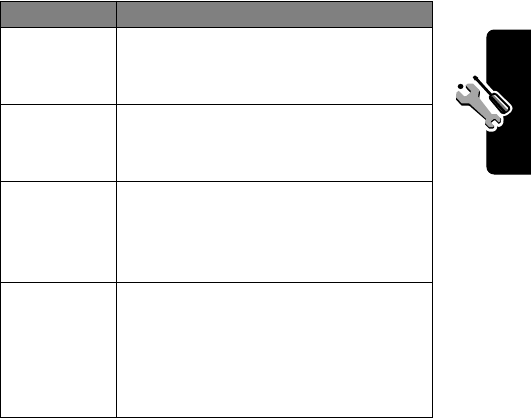
67
PRELIMINARY
Personalizing Your Phone
Answer
Options Set ways to answer incoming calls:
M
>
Settings
>
In-Call Setup
>
Answer Options
Main Menu Reorder your phone’s main menu:
M
>
Settings
>
Personalize
>
Main Menu
Soft Keys
& Menu
Icons
Change soft key labels and menu
feature icons in the idle display:
M
>
Settings
>
Personalize
>
Home Keys
Shortcuts Create a shortcut to a menu item:
Highlight the menu item, then press
and hold
M
Select a shortcut:
M
>
Shortcuts
>
shortcut name
Feature Description
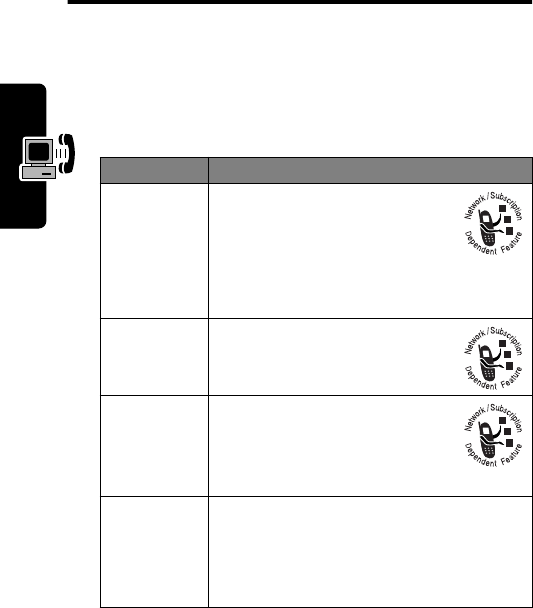
68
PRELIMINARY
Getting More Out Of Your Phone
Getting More Out Of
Your Phone
Note: See the reference guide for more information about
using the features described in this chapter.
Dialing Features
Feature Description
Fixed Dial Turn fixed dialing on or off:
M
>
Settings
>
Security
>
Fixed Dial
Use the fixed dial list:
M
>
More
>
Services
>
Fixed Dial
Service
Dial Dial service phone numbers:
M
>
More
>
Services
>
Service Dial
Quick Dial Dial pre-programmed phone
numbers:
M
>
More
>
Services
>
Quick Dial
DTMF
Tones Activate DTMF tones:
M
>
Settings
>
Initial Setup
>
DTMF
Send DTMF tones during a call:
M
>
Dialing Menu
>
Send Tones
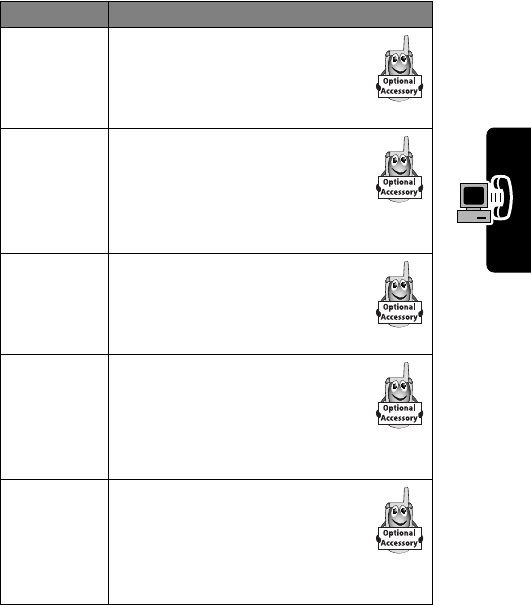
69
PRELIMINARY
Getting More Out Of Your Phone
Hands-Free Features
Feature Description
Speaker-
phone Activate a connected external
speakerphone during a call:
Press
SPEAKER
(
+
) (if available)
or
M
>
Spkrphone On
Auto
Answer
(car kit or
headset)
Automatically answer calls
when connected to a car kit or
headset:
M
>
Settings
>
Car Settings
or
Headset
>
Auto Answer
Auto
Hands-
Free
(car kit)
Automatically route calls to a
car kit when connected:
M
>
Settings
>
Car Settings
>
Auto Handsfree
Power-Off
Delay
(car kit)
Set the phone to stay on for a
period of time after the ignition
is switched off:
M
>
Settings
>
Car Settings
>
Power-Off Delay
Charger
Time
(car kit)
Charge the phone for a period
of time after the ignition is
switched off:
M
>
Settings
>
Car Settings
>
Charger Time
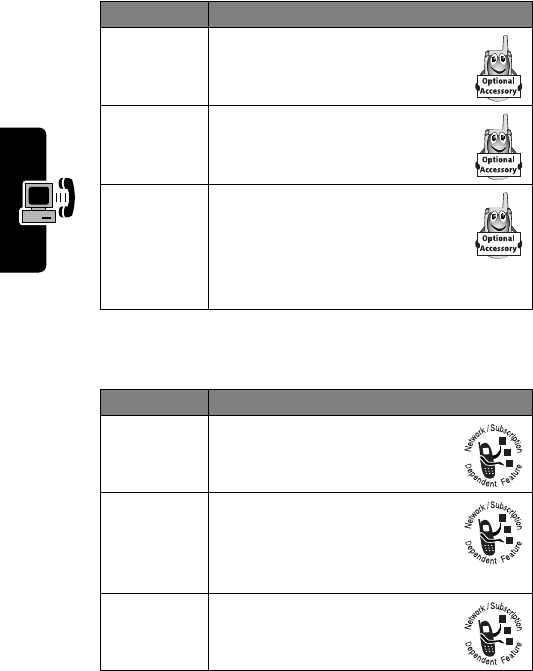
70
PRELIMINARY
Getting More Out Of Your Phone
Data and Fax Call Features
Call Monitoring Features
Feature Description
Send Data
or Fax Connect your phone to the
device, then place the call
through the device application
Receive
Data or
Fax
Connect your phone to the
device, then answer the call
through the device application
Talk Then
Fax Connect your phone to the
device, enter the number,
press
M
>
Dialing Menu
>
Talk Then Fax
, then press
N
to make the call
Feature Description
Call Times View call timers:
M
>
More
>
Recent Calls
>
Call Times
In-Call
Timer Display time or cost
information during a call:
M
>
Settings
>
In-Call Setup
>
In-Call Timer
Call Cost View call cost trackers:
M
>
More
>
Recent Calls
>
Call Cost
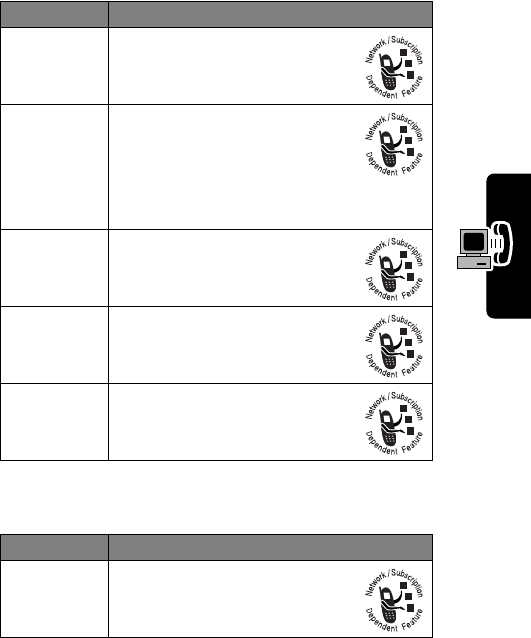
71
PRELIMINARY
Getting More Out Of Your Phone
Network Features
Credit Info
(prepay
option)
View credit information:
M
>
Settings
>
Phone Status
>
Credit Info
Credit
Available
(advice of
charge
option)
View credit available:
M
>
Settings
>
Phone Status
>
Credit Available
Call Cost
Setup Set a credit limit:
M
>
Settings
>
In-Call Setup
>
Call Cost Setup
Data
Times View data call timers:
M
>
More
>
Recent Calls
>
Data Times
Data
Volumes View data volume meters:
M
>
More
>
Recent Calls
>
Data Volumes
Feature Description
Network
Settings View network information and
adjust network settings:
M
>
Settings
>
Network
Feature Description

72
PRELIMINARY
Security
Security
Locking and Unlocking Your
Phone
You can lock your phone manually or set the phone to lock
automatically whenever you turn it off.
To use a locked phone, you must enter the unlock code. A
locked phone still rings or vibrates for incoming calls or
messages,
but you must unlock it to answer
.
You can make emergency calls on your phone even when
it is locked. For more information, see page 39.
Lock Your Phone Manually
Unlock Your Phone
Tip: Your phone’s unlock code is originally set to 1234 at
the factory. Many service providers reset the unlock code
to the last four digits of your phone number.
Find the Feature
M
>
Settings
>
Security
>
Phone Lock
>
Lock Now
Press To
1keypad keys enter your unlock code
2
OK
(
+
) lock the phone
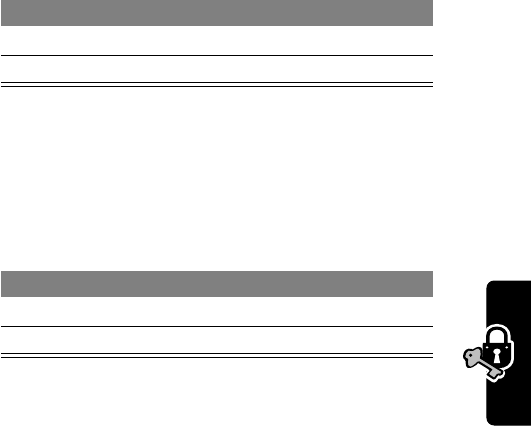
73
PRELIMINARY
Security
At the
Enter Unlock Code
prompt:
Set Your Phone to Lock Automatically
You can set your phone to lock every time you turn it off:
Changing a Code, PIN, or
Password
Your phone’s four-digit unlock code is originally set to
1234, and the six-digit security code is originally set to
000000 at the factory. Your service provider may reset
these numbers before you receive your phone.
If your service provider has
not
reset these numbers, we
recommend that you change them to prevent other users
from accessing your personal information. The unlock
code must contain four digits, and the security code must
contain six digits.
Press To
1keypad keys enter your unlock code
2
OK
(
+
) unlock your phone
Find the Feature
M
>
Settings
>
Security
>
Phone Lock
>
Automatic Lock
>
On
Press To
1keypad keys enter your unlock code
2
OK
(
+
) activate automatic lock
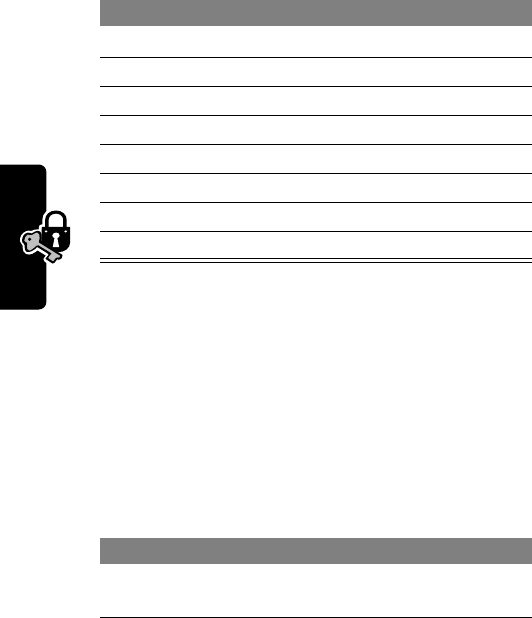
74
PRELIMINARY
Security
You can also reset your SIM card PIN code, PIN2 code,
and/or call barring password if necessary.
To change a code or password:
If You Forget a Code, PIN, or
Password
If you forget your security code, SIM card PIN code, PIN2
code, or call barring password, contact your service
provider.
If you forget your unlock code, try entering 1234 or the last
four digits of your phone number. If that does not work, do
the following at the
Enter Unlock Code
prompt:
Find the Feature
M
>
Settings
>
Security
>
New Passwords
Press To
1
S
scroll to the code or password
2
CHANGE
(
+
) select the code or password
3keypad keys enter your old code
4
OK
(
+
) submit your old code
5keypad keys enter the new code
6
OK
(
+
) assign the new code
7keypad keys re-enter the new code
8
OK
(
+
) confirm the new code
Press To
1
M
go to the unlock code bypass
screen
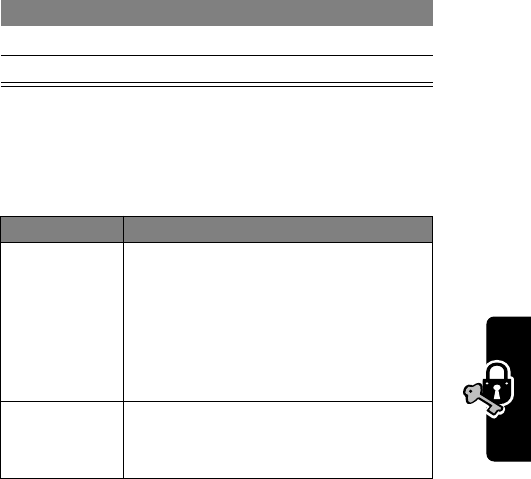
75
PRELIMINARY
Security
Other Security Features
Note: See the reference guide for more information about
using these features.
2keypad keys enter your security code
3
OK
(
+
) submit your security code
Feature Description
SIM PIN Lock or unlock the SIM card:
M
>
Settings
>
Security
>
SIM PIN
Caution: If you enter an incorrect
PIN code three times in a row, your
SIM card is disabled and your phone
displays
SIM Blocked
.
Lock
Application Lock phone applications:
M
>
Settings
>
Security
>
Lock Application
Press To
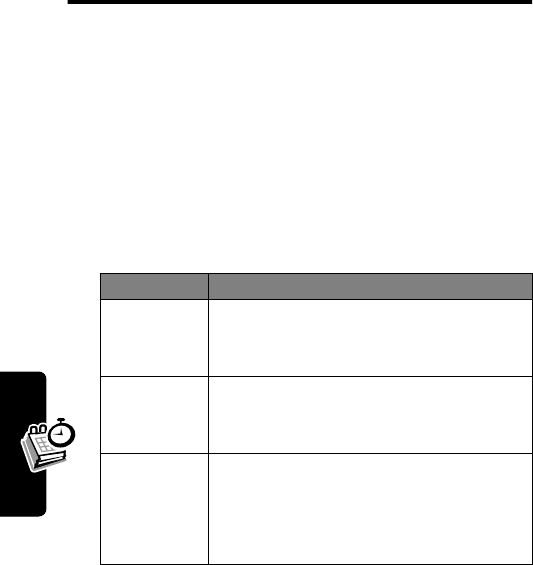
76
PRELIMINARY
Personal Organizer Features
Personal Organizer
Features
Note: See the reference guide for more information about
using the features described in this chapter.
Datebook
The datebook is a calendar that lets you schedule and
organize events such as appointments and meetings.
Note: You must set the correct time and date on your
phone to use the datebook. See page 36.
Feature Description
Add Event Add an event to the datebook:
M
>
More
>
Datebook
>
day
M
>
New
View
Event View or edit event details:
M
>
More
>
Datebook
>
day
>
event name
Event
Reminder View event reminder:
VIEW
(
+
)
Dismiss event reminder
EXIT
(
-
)
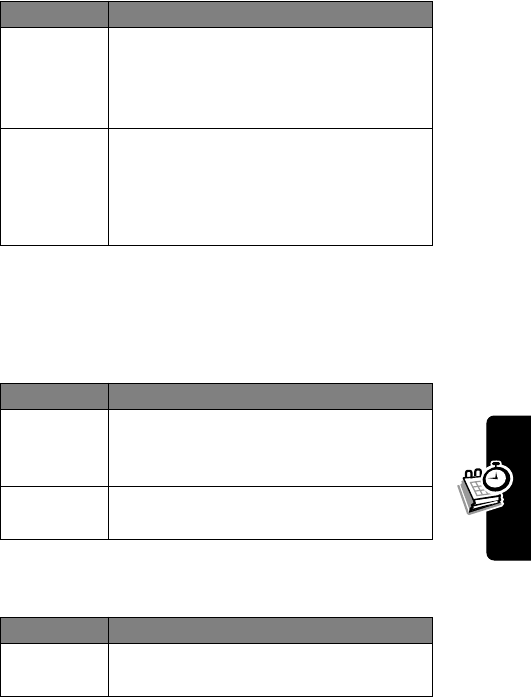
77
PRELIMINARY
Personal Organizer Features
Alarm Clock
Voice Notes
Record personal messages and phone calls on your
phone.
Calculator
Feature Description
Set Alarm Set the alarm clock (from the datebook
week view or day view):
M
>
More
>
Datebook
M
>
Alarm Clock
Turn Off
Alarm Turn off alarm:
Press
EXIT
(
-
) or
O
Set 8-minute delay:
Press
DELAY
(
+
)
Feature Description
Record Record a voice note:
Press and hold voice key, speak voice
note, release voice key
Play Play back a recorded voice note:
M
>
Voice Notes
>
voice note
Feature Description
Calculator Calculate numbers:
M
>
Calculator
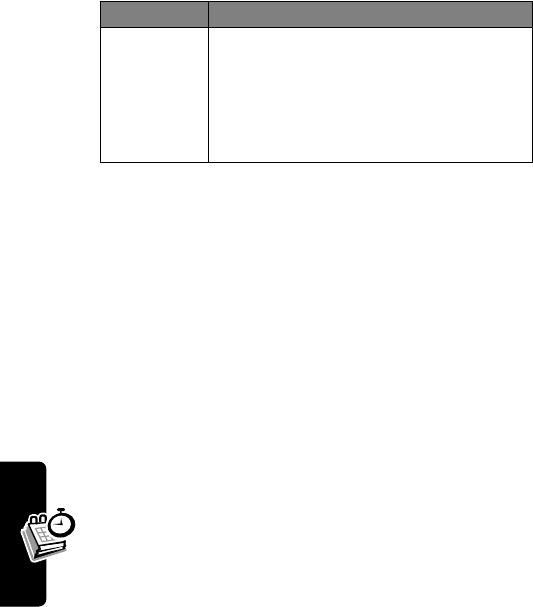
78
PRELIMINARY
Personal Organizer Features
Currency
Converter Convert currency:
M
>
Calculator
M
>
Exchange Rate
Enter exchange rate, press
OK
(
+
),
enter amount, select
$
function
Feature Description
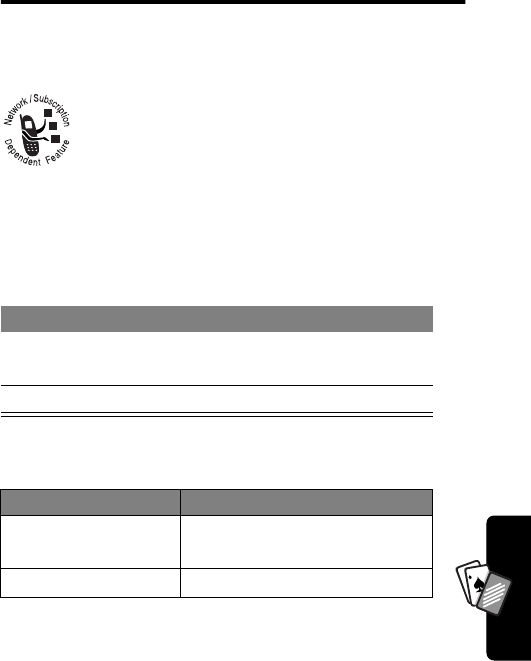
79
PRELIMINARY
News and Entertainment
A
7
A
News and
Entertainment
Micro-Browser
The micro-browser lets you access Web pages
and Web-based applications on your phone.
Contact your service provider to set up access,
if necessary.
Start a Micro-Browser Session
Interact With Web Pages
Find the Feature
M
>
Web Access
>
Browser
Press To
1
S
scroll to a bookmark, service,
or application
2
SELECT
(
+
) select the item
Press To
S
scroll through text, or
highlight a selectable item
SELECT
(
+
) select the highlighted item
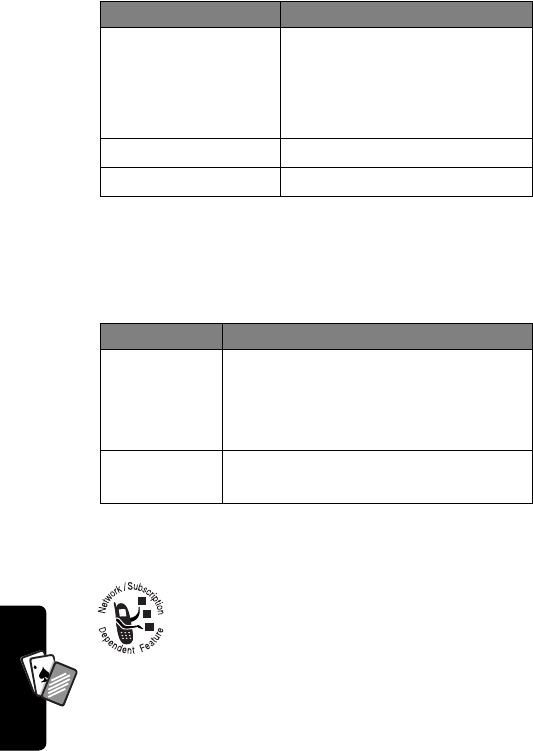
80
PRELIMINARY
News and Entertainment
A
7
A
Other Micro-Browser Features
Note: See the reference guide for more information about
using these features.
Games and Applications
Your phone contains several Java games
that you can play between calls. Each game
includes online playing instructions.
Your phone may contain additional Java
applications that add features and functionality to your
phone. Java games and applications are stored in the
Games & Apps
folder on your phone.
keypad keys,
followed by
OK
(
+
)enter information
Tip: Press
DELETE
(
-
) to
delete one letter at a time if
you make a mistake.
BACK
(
-
) go back to the previous page
M
open the
Browser Menu
Feature Description
Download
Picture or
Sound
Download a picture, animation, or
sound file from a Web page:
highlight the file, press
SELECT
(
+
),
press
STORE
(
+
)
Web
Sessions Select or create a Web session:
M
>
Web Sessions
Press To
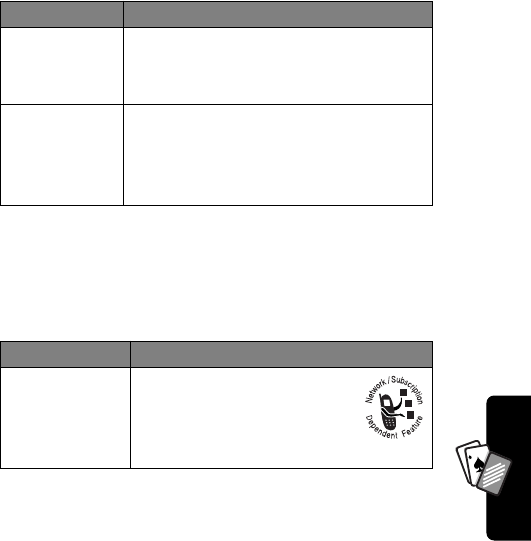
81
PRELIMINARY
News and Entertainment
A
7
A
You can download Java games and applications for your
phone from the Motorola Web site at:
http://www.hellomoto.com
Check the
Web Sessions
folder on your phone for additional
Web sites with downloadable Java applications.
Note: See the reference guide for more information about
using these features.
Other Entertainment Features
Note: See the reference guide for more information about
using these features.
Feature Description
Launch
Application Launch a Java application:
M
>
Games
& Apps
, highlight the
application, press
SELECT
(
+
)
Download
Application Download a Java application:
M
>
Web Access
>
Browser
, highlight
the application, press
SELECT
(
+
),
press
DWNLOAD
(
+
)
Feature Description
Picture
Viewer Manage pictures and
animations:
M
>
Media Center
>
Picture Viewer
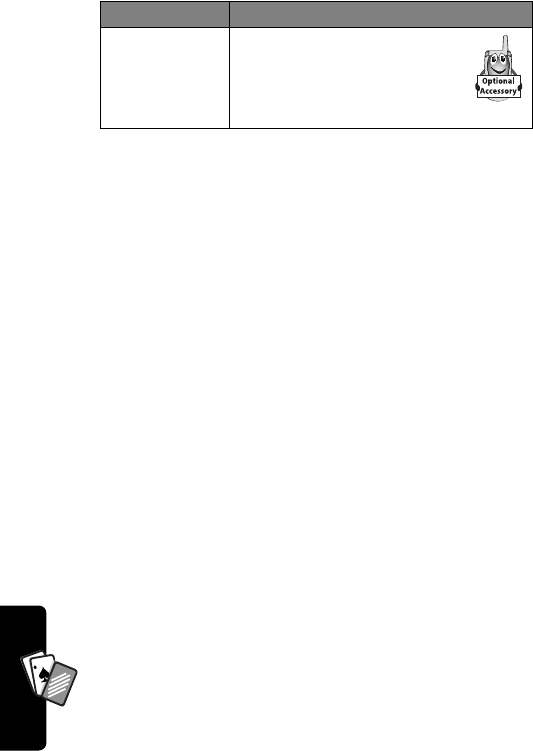
82
PRELIMINARY
News and Entertainment
A
7
A
Radio Use the optional Motorola
Original™ FM Stereo Radio
Headset accessory:
Press
RADIO
(
+
)
Feature Description

83
PRELIMINARY
Specific Absorption Rate Data
The selected product Motorola
T720 GSM
wireless phone
meets the government’s requirements for exposure to
radio waves.
Your wireless phone is a radio transmitter and receiver. It is designed and
manufactured not to exceed limits for exposure to radio frequency (RF)
energy set by the Federal Communications Commission (FCC) of the
U.S. Government and by Health Canada for Canada. These limits are part
of comprehensive guidelines and establish permitted levels of RF energy
for the general population. The guidelines are based on standards that
were developed by independent scientific organizations through periodic
and thorough evaluation of scientific studies. The standards include a
substantial safety margin designed to assure the safety of all persons,
regardless of age or health.
The exposure standard for wireless mobile phones employs a unit of
measurement known as the Specific Absorption Rate, or SAR. The SAR
limit set by the FCC and by Health Canada is 1.6W/kg.
1
Tests for SAR are
conducted using standard operating positions accepted by the FCC and
by Industry Canada with the phone transmitting at its highest certified
power level in all tested frequency bands. Although the SAR is
determined at the highest certified power level, the actual SAR level of the
phone while operating can be well below the maximum value. This is
because the phone is designed to operate at multiple power levels so as
to use only the power required to reach the network. In general, the closer
you are to a wireless base station, the lower the power output.
Before a phone model is available for sale to the public in the U.S. and
Canada, it must be tested and certified to the FCC and Industry Canada
that it does not exceed the limit established by each government for safe
exposure. The tests are performed in positions and locations (e.g., at the
ear and worn on the body) reported to the FCC and available for review by
Industry Canada. The highest SAR value for this model phone when
84
PRELIMINARY
tested for use at the ear is 1.09 W/kg, and when worn on the body, as
described in this user guide, is 0.88 W/kg. (Body-worn measurements
differ among phone models, depending upon available accessories and
regulatory requirements).
2
While there may be differences between the SAR levels of various phones
and at various positions, they all meet the governmental requirements for
safe exposure.
Additional information on Specific Absorption Rates (SAR) can be found
on the Cellular Telecommunications & Internet Association (CTIA) Web
site:
http://phonefacts.net
or the Canadian Wireless Telecommunications Association (CWTA) Web
site:
http://www.cwta.ca
1. In the United States and Canada, the SAR limit for mobile phones used by
the public is 1.6 watts/kg (W/kg) averaged over one gram of tissue. The
standard incorporates a substantial margin of safety to give additional
protection for the public and to account for any variations in measurements.
2. The SAR information includes the Motorola testing protocol, assessment
procedure, and measurement uncertainty range for this product.
ITC02-155

85
PRELIMINARY
The U.S. Food and Drug
Administration's Center for
Devices and Radiological Health
Consumer Update on Mobile Phones
Additional Health and Safety Information
FDA has been receiving inquiries about the safety of mobile phones,
including cellular phones and PCS phones. The following summarizes
what is known—and what remains unknown—about whether these
products can pose a hazard to health, and what can be done to minimize
any potential risk. This information may be used to respond to questions.
Why the concern?
Mobile phones emit low levels of radio frequency energy (i.e., radio
frequency radiation) in the microwave range while being used. They also
emit very low levels of radio frequency energy (RF), considered non-
significant, when in the stand-by mode. It is well known that high levels of
RF can produce biological damage through heating effects (this is how
your microwave oven is able to cook food). However, it is not known
whether, to what extent, or through what mechanism, lower levels of RF
might cause adverse health effects as well. Although some research has
been done to address these questions, no clear picture of the biological
effects of this type of radiation has emerged to date. Thus, the available
science does not allow us to conclude that mobile phones are absolutely
safe, or that they are unsafe. However, the available scientific evidence
does not demonstrate any adverse health effects associated with the use
of mobile phones.
What kinds of phones are in question?
Questions have been raised about hand-held mobile phones, the kind that
have a built-in antenna that is positioned close to the user's head during
normal telephone conversation. These types of mobile phones are of
concern because of the short distance between the phone's antenna—
86
PRELIMINARY
the primary source of the RF—and the person's head. The exposure to
RF from mobile phones in which the antenna is located at greater
distances from the user (on the outside of a car, for example) is drastically
lower than that from hand-held phones, because a person's RF exposure
decreases rapidly with distance from the source. The safety of so-called
“cordless phones,” which have a base unit connected to the telephone
wiring in a house and which operate at far lower power levels and
frequencies, has not been questioned.
How much evidence is there that hand-held
mobile phones might be harmful?
Briefly, there is not enough evidence to know for sure, either way;
however, research efforts are on-going. The existing scientific evidence is
conflicting and many of the studies that have been done to date have
suffered from flaws in their research methods. Animal experiments
investigating the effects of RF exposures characteristic of mobile phones
have yielded conflicting results. A few animal studies, however, have
suggested that low levels of RF could accelerate the development of
cancer in laboratory animals. In one study, mice genetically altered to be
predisposed to developing one type of cancer developed more than twice
as many such cancers when they were exposed to RF energy compared
to controls. There is much uncertainty among scientists about whether
results obtained from animal studies apply to the use of mobile phones.
First, it is uncertain how to apply the results obtained in rats and mice to
humans. Second, many of the studies that showed increased tumor
development used animals that had already been treated with cancer-
causing chemicals, and other studies exposed the animals to the RF
virtually continuously—up to 22 hours per day.
For the past five years in the United States, the mobile phone industry has
supported research into the safety of mobile phones. This research has
resulted in two findings in particular that merit additional study:
1In a hospital-based, case-control study, researchers looked for an
association between mobile phone use and either glioma (a type of
brain cancer) or acoustic neuroma (a benign tumor of the nerve
87
PRELIMINARY
sheath). No statistically significant association was found between
mobile phone use and acoustic neuroma. There was also no
association between mobile phone use and gliomas when all types of
types of gliomas were considered together. It should be noted that
the average length of mobile phone exposure in this study was less
than three years.
When 20 types of glioma were considered separately, however, an
association was found between mobile phone use and one rare type
of glioma, neuroepithelliomatous tumors. It is possible with multiple
comparisons of the same sample that this association occurred by
chance. Moreover, the risk did not increase with how often the mobile
phone was used, or the length of the calls. In fact, the risk actually
decreased with cumulative hours of mobile phone use. Most cancer
causing agents increase risk with increased exposure. An ongoing
study of brain cancers by the National Cancer Institute is expected to
bear on the accuracy and repeatability of these results.
1
2Researchers conducted a large battery of laboratory tests to assess
the effects of exposure to mobile phone RF on genetic material.
These included tests for several kinds of abnormalities, including
mutations, chromosomal aberrations, DNA strand breaks, and
structural changes in the genetic material of blood cells called
lymphocytes. None of the tests showed any effect of the RF except
for the micronucleus assay, which detects structural effects on the
genetic material. The cells in this assay showed changes after
exposure to simulated cell phone radiation, but only after 24 hours of
exposure. It is possible that exposing the test cells to radiation for this
long resulted in heating. Since this assay is known to be sensitive to
heating, heat alone could have caused the abnormalities to occur.
The data already in the literature on the response of the micronucleus
assay to RF are conflicting. Thus, follow-up research is necessary.
2
FDA is currently working with government, industry, and academic groups
to ensure the proper follow-up to these industry-funded research findings.
Collaboration with the Cellular Telecommunications Industry Association
(CTIA) in particular is expected to lead to FDA providing research
88
PRELIMINARY
recommendations and scientific oversight of new CTIA-funded research
based on such recommendations.
Two other studies of interest have been reported recently in the literature:
1Two groups of 18 people were exposed to simulated mobile phone
signals under laboratory conditions while they performed cognitive
function tests. There were no changes in the subjects' ability to recall
words, numbers, or pictures, or in their spatial memory, but they were
able to make choices more quickly in one visual test when they were
exposed to simulated mobile phone signals. This was the only
change noted among more than 20 variables compared.
3
2In a study of 209 brain tumor cases and 425 matched controls, there
was no increased risk of brain tumors associated with mobile phone
use. When tumors did exist in certain locations, however, they were
more likely to be on the side of the head where the mobile phone was
used.
Because this occurred in only a small number of cases, the increased
likelihood was too small to be statistically significant.
4
In summary, we do not have enough information at this point to assure the
public that there are, or are not, any low incident health problems
associated with use of mobile phones. FDA continues to work with all
parties, including other federal agencies and industry, to assure that
research is undertaken to provide the necessary answers to the
outstanding questions about the safety of mobile phones.
What is known about cases of human cancer
that have been reported in users of hand-held
mobile phones?
Some people who have used mobile phones have been diagnosed with
brain cancer. But it is important to understand that this type of cancer also
occurs among people who have not used mobile phones. In fact, brain
cancer occurs in the U.S. population at a rate of about 6 new cases per
100,000 people each year. At that rate, assuming 80 million users of
89
PRELIMINARY
mobile phones (a number increasing at a rate of about 1 million per
month), about 4800 cases of brain cancer would be expected each year
among those 80 million people, whether or not they used their phones.
Thus it is not possible to tell whether any individual's cancer arose
because of the phone, or whether it would have happened anyway. A key
question is whether the risk of getting a particular form of cancer is
greater among people who use mobile phones than among the rest of the
population. One way to answer that question is to compare the usage of
mobile phones among people with brain cancer with the use of mobile
phones among appropriately matched people without brain cancer. This is
called a case-control study. The current case-control study of brain
cancers by the National Cancer Institute, as well as the follow-up research
to be sponsored by industry, will begin to generate this type of
information.
What is FDA's role concerning the safety of
mobile phones?
Under the law, FDA does not review the safety of radiation-emitting
consumer products such as mobile phones before marketing, as it does
with new drugs or medical devices. However, the agency has authority to
take action if mobile phones are shown to emit radiation at a level that is
hazardous to the user. In such a case, FDA could require the
manufacturers of mobile phones to notify users of the health hazard and
to repair, replace or recall the phones so that the hazard no longer exists.
Although the existing scientific data do not justify FDA regulatory actions
at this time, FDA has urged the mobile phone industry to take a number of
steps to assure public safety. The agency has recommended that the
industry:
•support needed research into possible biological effects of RF of the
type emitted by mobile phones
•design mobile phones in a way that minimizes any RF exposure to
the user that is not necessary for device function
90
PRELIMINARY
•cooperate in providing mobile phone users with the best possible
information on what is known about possible effects of mobile phone
use on human health
At the same time, FDA belongs to an interagency working group of the
federal agencies that have responsibility for different aspects of mobile
phone safety to ensure a coordinated effort at the federal level. These
agencies are:
•National Institute for Occupational Safety and Health
•Environmental Protection Agency
•Federal Communications Commission
•Occupational Health and Safety Administration
•National Telecommunications and Information Administration
The National Institutes of Health also participates in this group.
In the absence of conclusive information about
any possible risk, what can concerned
individuals do?
If there is a risk from these products—and at this point we do not know
that there is—it is probably very small. But if people are concerned about
avoiding even potential risks, there are simple steps they can take to do
so. For example, time is a key factor in how much exposure a person
receives. Those persons who spend long periods of time on their hand-
held mobile phones could consider holding lengthy conversations on
conventional phones and reserving the hand-held models for shorter
conversations or for situations when other types of phones are not
available.
People who must conduct extended conversations in their cars every day
could switch to a type of mobile phone that places more distance between
their bodies and the source of the RF, since the exposure level drops off
dramatically with distance. For example, they could switch to:
•a mobile phone in which the antenna is located outside the vehicle
91
PRELIMINARY
•a hand-held phone with a built-in antenna connected to a different
antenna mounted on the outside of the car or built into a separate
package
•a headset with a remote antenna to a mobile phone carried at the
waist
Again, the scientific data do not demonstrate that mobile phones are
harmful. But if people are concerned about the radio frequency energy
from these products, taking the simple precautions outlined above can
reduce any possible risk.
Where can I find additional information?
For additional information, see the following Web sites:
Federal Communications Commission
(FCC) RF Safety Program
(select “Information on Human Exposure to RF Fields from Cellular and
PCS Radio Transmitters”):
http://www.fcc.gov/oet/rfsafety
World Health Organization
(WHO) International Commission on
Non-Ionizing Radiation Protection (select Qs & As):
http://
www.who.int/emf
United Kingdom, National Radiological Protection Board
:
http://www.nrpb.org.uk
Cellular Telecommunications Industry Association
(CTIA):
http://www.wow-com.com
U.S. Food and Drug Administration
(FDA) Center for Devices and
Radiological Health:
http://www.fda.gov/cdrh/consumer/
92
PRELIMINARY
1. Muscat et al. Epidemiological Study of Cellular Telephone Use and
Malignant Brain Tumors. In: State of the Science Symposium;1999 June 20;
Long Beach, California.
2. Tice et al. Tests of mobile phone signals for activity in genotoxicity and other
laboratory assays. In: Annual Meeting of the Environmental Mutagen
Society; March 29, 1999, Washington, D.C.; and personal communication,
unpublished results.
3. Preece, AW, Iwi, G, Davies-Smith, A, Wesnes, K, Butler, S, Lim, E, and Varey,
A. Effect of a 915-MHz simulated mobile phone signal on cognitive function
in man. Int. J. Radiat. Biol., April 8, 1999.
4. Hardell, L, Nasman, A, Pahlson, A, Hallquist, A and Mild, KH. Use of cellular
telephones and the risk for brain tumors: a case-control study. Int. J. Oncol.,
15: 113-116, 1999.
ITC00-010

93
PRELIMINARY
Motorola Limited Warranty for
the United States and Canada
Warranty
What Does this Warranty Cover?
Subject to the exclusions contained below, Motorola, Inc. warrants its
telephones, pagers, and consumer and professional two-way radios
(excluding commercial, government or industrial radios) that operate via
Family Radio Service or General Mobile Radio Service, Motorola-branded
or certified accessories sold for use with these Products (“Accessories”)
and Motorola software contained on CD-ROMs or other tangible media
and sold for use with these Products (“Software”) to be free from defects
in materials and workmanship under normal consumer usage for the
period(s) outlined below. This limited warranty is a consumer's exclusive
remedy, and applies as follows to new Motorola Products, Accessories
and Software purchased by consumers in the United States or Canada,
which are accompanied by this written warranty:
Products and Accessories
Products Covered Length of Coverage
Products and Accessories as
defined above, unless otherwise
provided for below.
One (1) year from the date of
purchase by the first consumer
purchaser of the product unless
otherwise provided for below.
Decorative Accessories and
Cases. Decorative covers,
bezels, PhoneWrap™ covers and
cases.
Limited lifetime warranty for the
lifetime of ownership by the first
consumer purchaser of the
product.
Monaural Headsets. Ear buds
and boom headsets that transmit
mono sound through a wired
connection.
Limited lifetime warranty for the
lifetime of ownership by the first
consumer purchaser of the
product.

94
PRELIMINARY
Exclusions
Normal Wear and Tear. Periodic maintenance, repair and replacement of
parts due to normal wear and tear are excluded from coverage.
Batteries. Only batteries whose fully charged capacity falls below 80% of
their rated capacity and batteries that leak are covered by this limited
warranty.
Abuse & Misuse. Defects or damage that result from: (a) improper
operation, storage, misuse or abuse, accident or neglect, such as
physical damage (cracks, scratches, etc.) to the surface of the product
resulting from misuse; (b) contact with liquid, water, rain, extreme
humidity or heavy perspiration, sand, dirt or the like, extreme heat, or
food; (c) use of the Products or Accessories for commercial purposes or
subjecting the Product or Accessory to abnormal usage or conditions; or
(d) other acts which are not the fault of Motorola, are excluded from
coverage.
Use of Non-Motorola Products and Accessories. Defects or damage
that result from the use of Non-Motorola branded or certified Products,
Accessories, Software or other peripheral equipment are excluded from
coverage.
Unauthorized Service or Modification. Defects or damages resulting
from service, testing, adjustment, installation, maintenance, alteration, or
modification in any way by someone other than Motorola, or its authorized
service centers, are excluded from coverage.
Consumer and Professional
Two-Way Radio Accessories. Ninety (90) days from the date of
purchase by the first consumer
purchaser of the product.
Products and Accessories that
are Repaired or Replaced. The balance of the original
warranty or for ninety (90) days
from the date returned to the
consumer, whichever is longer.
Products Covered Length of Coverage

95
PRELIMINARY
Altered Products. Products or Accessories with (a) serial numbers or
date tags that have been removed, altered or obliterated; (b) broken seals
or that show evidence of tampering; (c) mismatched board serial
numbers; or (d) nonconforming or non-Motorola housings, or parts, are
excluded from coverage.
Communication Services. Defects, damages, or the failure of Products,
Accessories or Software due to any communication service or signal you
may subscribe to or use with the Products Accessories or Software is
excluded from coverage.
Software
Exclusions
Software Embodied in Physical Media. No warranty is made that the
software will meet your requirements or will work in combination with any
hardware or software applications provided by third parties, that the
operation of the software products will be uninterrupted or error free, or
that all defects in the software products will be corrected.
Software NOT Embodied in Physical Media. Software that is not
embodied in physical media (e.g. software that is downloaded from the
internet), is provided “as is” and without warranty.
Who is Covered?
This warranty extends only to the first consumer purchaser, and is not
transferable.
What Will Motorola Do?
Motorola, at its option, will at no charge repair, replace or refund the
purchase price of any Products, Accessories or Software that does not
conform to this warranty. We may use functionally equivalent
Products Covered Length of Coverage
Software. Applies only to physical defects
in the media that embodies the copy of the
software (e.g. CD-ROM, or floppy disk).
Ninety (90) days from
the date of purchase.

96
PRELIMINARY
reconditioned/refurbished/pre-owned or new Products, Accessories or
parts. No data, software or applications added to your Product, Accessory
or Software, including but not limited to personal contacts, games and
ringer tones, will be reinstalled. To avoid losing such data, software and
applications please create a back up prior to requesting service.
How to Obtain Warranty Service or Other
Information?
You will receive instructions on how to ship the Products, Accessories or
Software, at your expense, to a Motorola Authorized Repair Center. To
obtain service, you must include: (a) a copy of your receipt, bill of sale or
other comparable proof of purchase; (b) a written description of the
problem; (c) the name of your service provider, if applicable; (d) the name
and location of the installation facility (if applicable) and, most importantly;
(e) your address and telephone number.
What Other Limitations Are There?
ANY IMPLIED WARRANTIES, INCLUDING WITHOUT LIMITATION THE
IMPLIED WARRANTIES OF MERCHANTABILITY AND FITNESS FOR A
PARTICULAR PURPOSE, SHALL BE LIMITED TO THE DURATION OF
THIS LIMITED WARRANTY, OTHERWISE THE REPAIR,
REPLACEMENT, OR REFUND AS PROVIDED UNDER THIS EXPRESS
LIMITED WARRANTY IS THE EXCLUSIVE REMEDY OF THE
CONSUMER, AND IS PROVIDED IN LIEU OF ALL OTHER
WARRANTIES, EXPRESS OF IMPLIED. IN NO EVENT SHALL
MOTOROLA BE LIABLE, WHETHER IN CONTRACT OR TORT
USA Phones 1-800-331-6456
Two-Way Radios 1-800-353-2729
Pagers 1-800-548-9954
Canada All Products 1-800-461-4575
TTY 1-888-390-6456
For Accessories and Software, please call the telephone number
designated above for the product with which they are used.
97
PRELIMINARY
(INCLUDING NEGLIGENCE) FOR DAMAGES IN EXCESS OF THE
PURCHASE PRICE OF THE PRODUCT, ACCESSORY OR SOFTWARE,
OR FOR ANY INDIRECT, INCIDENTAL, SPECIAL OR
CONSEQUENTIAL DAMAGES OF ANY KIND, OR LOSS OF REVENUE
OR PROFITS, LOSS OF BUSINESS, LOSS OF INFORMATION OR
DATA, SOFTWARE OR APPLICATIONS OR OTHER FINANCIAL LOSS
ARISING OUT OF OR IN CONNECTION WITH THE ABILITY OR
INABILITY TO USE THE PRODUCTS, ACCESSORIES OR SOFTWARE
TO THE FULL EXTENT THESE DAMAGES MAY BE DISCLAIMED BY
LAW.
Some states and jurisdictions do not allow the limitation or
exclusion of incidental or consequential damages, or limitation on
the length of an implied warranty, so the above limitations or
exclusions may not apply to you. This warranty gives you specific
legal rights, and you may also have other rights that vary from state
to state or from one jurisdiction to another.
Laws in the United States and other countries preserve for Motorola
certain exclusive rights for copyrighted Motorola software such as the
exclusive rights to reproduce and distribute copies of the Motorola
software. Motorola software may only be copied into, used in, and
redistributed with, the Products associated with such Motorola software.
No other use, including without limitation disassembly of such Motorola
software or exercise of the exclusive rights reserved for Motorola, is
permitted.
ITC02-159

98
PRELIMINARY
Product Registration
Online Product Registration:
http://www.motorola.com/warranty
Product registration is an important step toward enjoying your new
Motorola phone. Registering helps us facilitate warranty service, and
permits us to contact you should your phone require an update or other
service. Registration is for U.S. residents only and is not required for
warranty coverage.
Please retain your original dated sales receipt for your records. For
warranty service of your Motorola Personal Communications Product you
will need to provide a copy of your dated sales receipt to confirm warranty
status.
Thank you for choosing a Motorola product.
Export Law Assurances
This product is controlled under the export regulations of the United
States of America and Canada. The Governments of the United States of
America and Canada may restrict the exportation or re-exportation of this
product to certain destinations. For further information contact the U.S.
Department of Commerce or the Canadian Department of Foreign Affairs
and International Trade.

99
PRELIMINARY
Index
A
accessories
optional 15
standard 14
accessory connector port 1
active line indicator 25, 26
alarm clock 77
alert
creating 66
defined 64
setting 65
turning off 23, 44
animation
inserting in message 49
screen saver 66
storing 49, 80
viewing 81
wallpaper 66
answering a call 24
appointments.
See
datebook
automatic redial 44
B
backlight 27
banner 66
barring calls 45
battery
car kit charger time 69
charging 18–19
extending battery life
19–20, 27, 37
installing 17–18
level indicator 19, 25, 26
browse text mode 30
browser alerts 49
C
calculator 77–78
calendar.
See
datebook
call
alert 23, 44, 65
answer options 67
answering 24
barring 45
call waiting 43
calling card 60
canceling 44
costs 70, 71
credit limit 71
dialed calls list 40–41
dialing 23
emergency number 39
ending 24
forwarding 45
100
PRELIMINARY
call (continued)
hold 45
international access code
40
making 23
received calls list 40–41
recent calls 40–41
speakerphone 69
timing 70
transferring 45
call barring password,
changing 74
call cost information 70
call timers 70
call waiting 43
caller ID 38–39
calling card call 60
calling line identification.
See
caller ID
car kit
automatic answer 69
automatic hands-free 69
charger time 69
power-off delay 69
chat 50–52
clock
illustration 25
setting 36
codes
changing 73–74
default 72, 73
forgetting 74
color, display 66
conference call 45
contrast, display 27
convertible covers 21
credit information 71
D
data call
receive 70
send 70
timers 71
volume meters 71
date, setting 36
datebook 76
datebook icon 25
dialed calls list 40–41
dialing
fixed numbers 68
phone number 23
quick dial numbers 68
service numbers 68
display
banner 66
color 66
contrast 27
description 25–27
greeting 66
idle display 25
illustration 25
language 29
101
PRELIMINARY
display (continued)
menu icons, personalizing
67
zooming in/out 27
distinctive ringer alert 65
drafts folder 48, 50
DTMF tones 68
E
earpiece volume, adjusting
23
email
address, storing 58–59
deleting 56
inbox setup 56
locking 56
outbox 56
personal folders 56
quick note 56
reading 56
receiving 55
reminders, receiving 55
reminders, turning on/off
66
sending 46–48, 53–55,
62–63
sending manually 56
emergency number 39
end key 1, 24, 28
ending a call 24
Enter Unlock Code
message
73, 74
event alert 65
F
fax call
receive 70
send 70
fixed dial 68
flip
activating 24, 67
using 22
FM Stereo Radio Headset
82
forwarding calls 45
4-way navigation key 1, 28
G
games 80–81
GPRS indicator 25, 26
greeting 66
H
hands-free use
automatic answer 69
automatic call routing 69
charger time 69
power-off delay 69
speakerphone, activating
69
102
PRELIMINARY
headset
automatic answer 69
FM Stereo Radio Headset
82
headset jack 1
Hide ID
feature 38
hold a call 45
home keys, personalizing
67
I
idle display, defined 25
in use indicator 25, 26
incoming call
canceling 44
Incoming Call
message 38
indicators
active line 25, 26
battery level 19, 25, 26
GPRS 25, 26
in use 25, 26
loud ring style 26, 64
menu 25, 27
message waiting 25, 27,
48, 55
ring style 25, 26, 64
roam 25, 26
signal strength 25, 26
silent alert 26
silent ring style 26, 64
soft ring style 26, 64
text entry mode 25, 26
indicators (continued)
vibrate and ring style 26,
64
vibrate style 26, 64
voice message waiting
42
voice name 57
information services 50
international access code
40
iTAP software 33–36
J
Java applications 80–81
joystick 1, 28
K
key
end 1, 24, 28
4-way navigation 1, 28
left soft key 1, 26, 28, 67
menu 1, 15, 27, 28
power 1, 22
right soft key 1, 26, 28,
67
send 1, 24, 40
voice 1
volume control 1, 23
keypad
volume, adjusting 66
103
PRELIMINARY
L
language, setting 29
left soft key
functions 1, 26, 28
personalizing 67
lock
SIM card 75
lock phone 72–73
loud ring style indicator 26,
64
Low Battery
message 26
M
making a call 23
master clear 29
master reset 29
Memory is Full!
message
48, 51, 55
menu
entering text 30–36
icons, changing in idle
display 67
icons, described 25
language, setting 29
navigating 15, 28
personalizing 67
rearranging features 67
using features 14
menu indicator 25, 27
menu key 1, 15, 27, 28
message
browser alerts 49
chat 50–52
deleting 49
drafts 48, 50
email 53–56
inbox setup 49
information services 50
locking 49
outbox 49
quick note 49
reading 49
receiving 48
reminders, receiving 48
reminders, turning on/off
66
sending 46–48
status 49
message waiting indicator
25, 27, 48, 55
messages icon 25
micro-browser
browser alerts 49
browser setup 80
Java applications 80–81
using 79–80
Web sessions 80
microphone 1
my telephone number 22,
36, 44
my tones 66
104
PRELIMINARY
N
network settings 71
notepad 44
number
storing your number 36
viewing your number 22,
44
numeric text mode 30
O
1-touch dial
using 41
optional accessory, defined
15
optional feature, defined 15
outbox 49, 56
P
passwords.
See
codes
pause character 60, 61
phone
accessories, standard 14
active line indicator 26
active phone line,
changing 37
alert 44, 65
alert, turning off 23
answer options 67
clear stored information
29
clock, setting 36
phone (continued)
codes 73–75
credit information 71
date, setting 36
flip 22, 24
language, setting 29
locking 72–73
network settings 71
reset all options 29
security code 73
time, setting 36
turning on/off 22
unlock code 72, 73, 74
unlocking 22, 72–73
phone number
active line indicator 26
active phone line,
changing 37
attaching two numbers
44
international access code
40
redialing 38
storing in phonebook
58–59
storing your number 36
viewing your number 22,
44
phonebook
attaching two numbers
44
dialing a number 62–63
105
PRELIMINARY
phonebook (continued)
editing an entry 63
entry details 57
icon 25
number type indicator 57
1-touch dial 41
ringer ID 59, 65
sending an email 62–63
speed dial number 57
speed dial number,
setting 59
speed dial, using 41
storing an entry 58–59
voice name, recording
61–62
picture
inserting in message 49
screen saver 66
storing 49, 80
viewing 81
wallpaper 66
PIN code
changing 74
entering 75
storing with phonebook
entry 60
PIN2 code
changing 74
power key 1, 22
predictive text entry 33–36
Q
quick dial 68
quick note 49, 56
quick note, defined 46
R
radio 82
received calls list 40–41
recent calls 40–41
redial
automatic redial 44
busy number 38
reference guide 14
reminders
email message 55
text message 48
turning on/off 66
right soft key
functions 1, 26, 28
personalizing 67
ring alert
setting 65
turning off 23, 44
ring style
defined 64
indicators 26
personalizing 65
setting 64
ring style indicator 25, 26,
64
106
PRELIMINARY
ringer ID
setting 59
turning on/off 65
ringer volume, adjusting 23,
65
roam indicator 25, 26
S
screen saver 66
security code
changing 73–74
default 73
send key 1, 24, 40
service dial 68
short message service.
See
message
shortcuts
creating 67
standard 3
Show ID
feature 38
signal strength indicator 25,
26
silent alert indicator 26
silent ring style indicator 26,
64
SIM Blocked
message 22,
75
SIM card
defined 15
installing 15–16
locking 75
PIN code entry 22
SIM card (continued)
PIN code, changing 74
PIN2 code, changing 74
precautions 16
SIM Blocked
message 22,
75
SIM PIN code
entering 75
SIM PIN code, changing 74
SIM PIN2 code
changing 74
SMS.
See
message
soft keys
functions 26, 28
illustration 1
labels 25
personalizing 67
soft ring style indicator 26,
64
sound
inserting in message 49
storing 49, 80
speakerphone, activating
69
speed dial
setting number 59
using 41
status light 1, 36
107
PRELIMINARY
T
tap method text entry
30–32
telephone number
storing your number 36
viewing your number 22,
44
text
browse mode 30
character chart 32
entering from keypad
30–36
entry mode, changing 30
iTAP software predictive
text entry 33–36
numeric mode 30
tap method 30–32
text entry mode indicator
25, 26
text mode, changing 30
time, setting 36
timers 70
transfer a call 45
travel charger, using 18
U
unlock code
bypassing 74
changing 73–74
default 72, 73
unlock code (continued)
entering 22, 72, 73
forgetting 74
unlock phone 72–73
user group 75
V
vibrate alert
setting 65
turning off 23, 44
vibrate and ring style
indicator 26, 64
vibrate ring style
setting 64
vibrate style
indicator 26, 64
voice dial
dialing a number 63
recording a voice name
61–62
voice key
dialing a number 63
illustration 1
recording a voice name
61–62
voice message waiting
indicator 42
voice name indicator 57
voice name, recording
61–62
voice notes 77
voicemail 41–42
108
PRELIMINARY
volume
earpiece 23
keypad 66
ringer 23, 65
volume keys 1, 23
W
wait character 60
wallpaper 66
warranty 93–97
Web access icon 25
Web pages 79–80
Web sessions 80
Z
zooming in/out 27
U.S. patent Re. 34,976
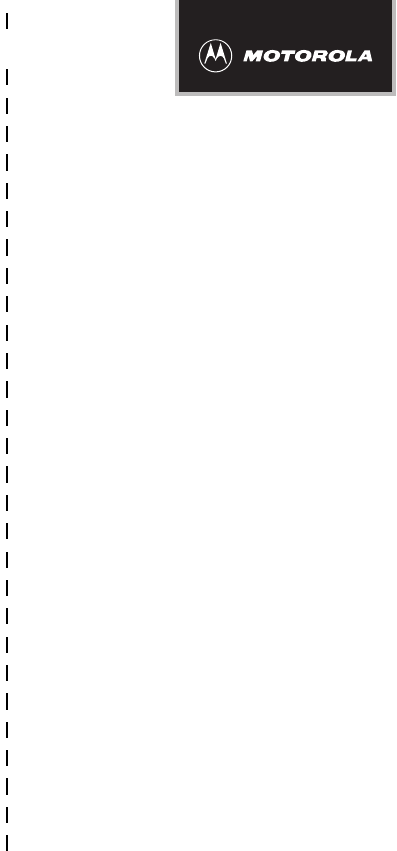
✂
PRELIMINARY
109
Wireless Phone Safety
Tips
“Safety is your most important call!”
Your Motorola wireless telephone gives you
the powerful ability to communicate by voice—
almost anywhere, anytime, wherever wireless
phone service is available and safe conditions allow.
But an important responsibility accompanies the
benefits of wireless phones, one that every user
must uphold.
When driving a car, driving is your first
responsibility. If you find it necessary to use your
wireless phone while behind the wheel of a car,
practice good common sense and remember the
following tips:
1 Get to know your Motorola wireless phone and its
features such as speed dial and redial. If available,
these features help you to place your call without taking
your attention off the road.

✂
PRELIMINARY
110
2 When available, use a hands-free device. If possible,
add an additional layer of convenience to your wireless
phone with one of the many Motorola Original™ hands-
free accessories available today.
3 Position your wireless phone within easy reach. Be
able to access your wireless phone without removing
your eyes from the road. If you receive an incoming call
at an inconvenient time, if possible, let your voice mail
answer it for you.
4 Let the person you are speaking with know you are
driving; if necessary, suspend the call in heavy
traffic or hazardous weather conditions. Rain, sleet,
snow, ice, and even heavy traffic can be hazardous.
5 If you receive an incoming call at an inconvenient
time do not take notes or look up phone numbers
while driving. Jotting down a “to do” list or going
through your address book takes attention away from
your primary responsibility—driving safely.
6 Dial sensibly and assess the traffic; if possible,
place calls when you are not moving or before
pulling into traffic. Try to plan calls when your car will
be stationary. If you need to make a call while moving,
dial only a few numbers, check the road and your
mirrors, then continue.
7 Do not engage in stressful or emotional
conversations that may be distracting. Make people
you are talking with aware you are driving and suspend
conversations which have the potential to divert your
attention away from the road.

✂
PRELIMINARY
111
8 Use your wireless phone to call for help. Dial 9-1-1 or
other local emergency number in the case of fire, traffic
accident or medical emergencies.*
9 Use your wireless phone to help others in
emergencies. If you see an auto accident, crime in
progress or other serious emergency where lives are in
danger, call 9-1-1 or other local emergency number, as
you would want others to do for you.*
10 Call roadside assistance or a special
non-emergency wireless assistance number when
necessary. If you see a broken-down vehicle posing no
serious hazard, a broken traffic signal, a minor traffic
accident where no one appears injured, or a vehicle you
know to be stolen, call roadside assistance or other
special non-emergency wireless number.*
* Wherever wireless phone service is available.

✂
PRELIMINARY
112
Check the laws and regulations on the use of
wireless telephones and their accessories in the
areas where you drive. Always obey them. The
use of these devices may be prohibited or
restricted in certain areas.
For more information,
please call
1-888-901-SAFE
or visit the
CTIA Web site at
www.wow-com.com™
ITC00-011